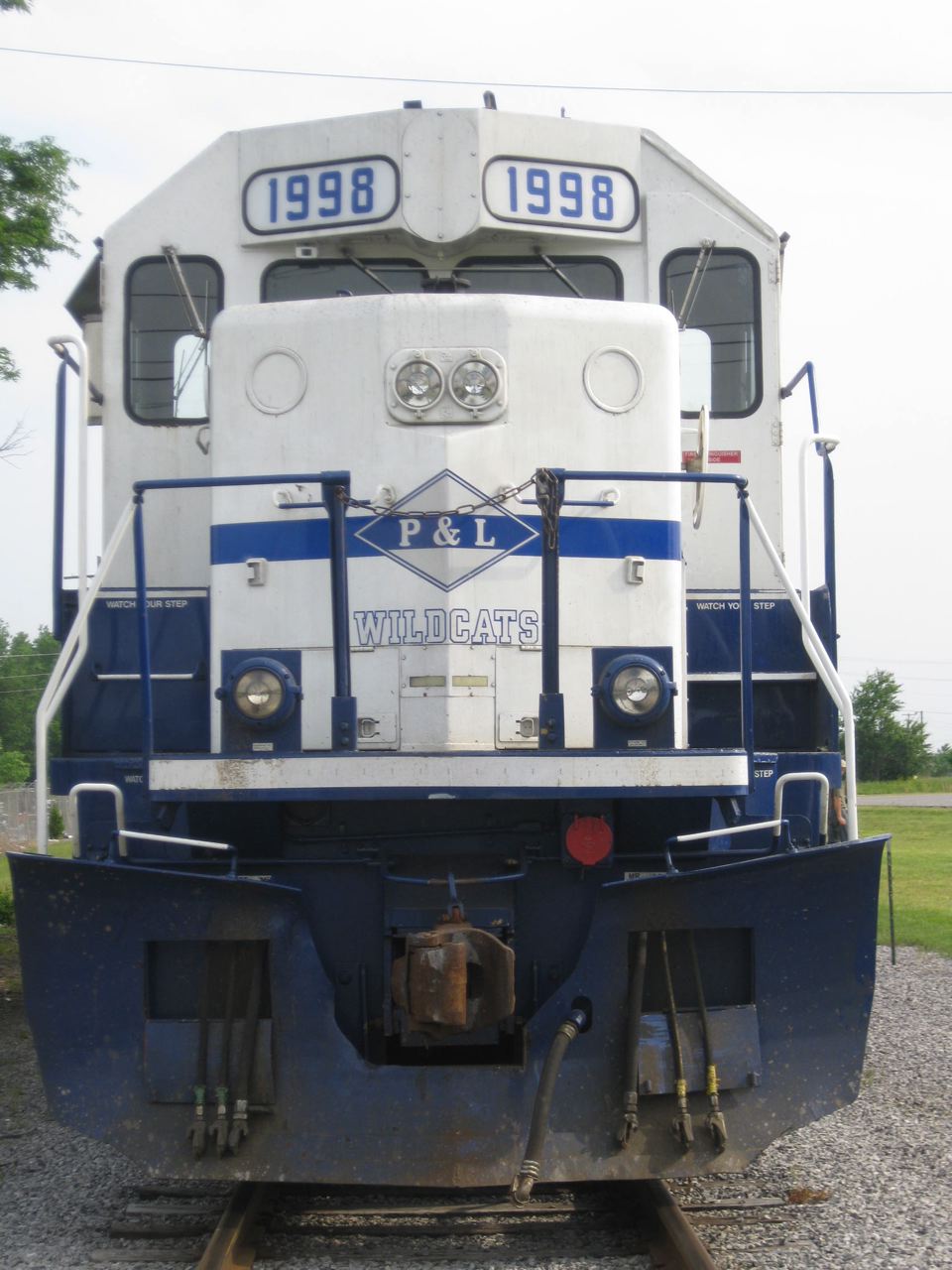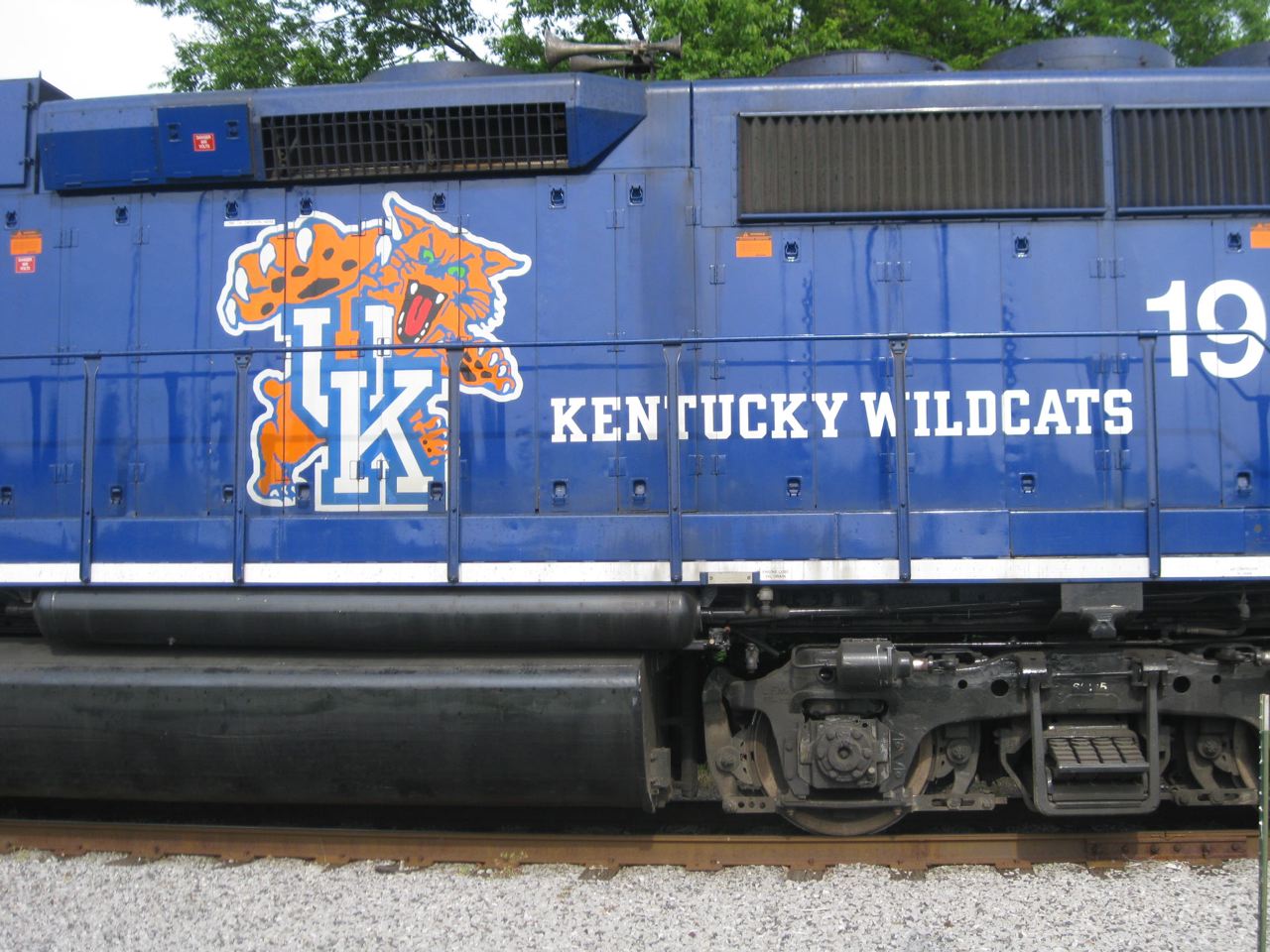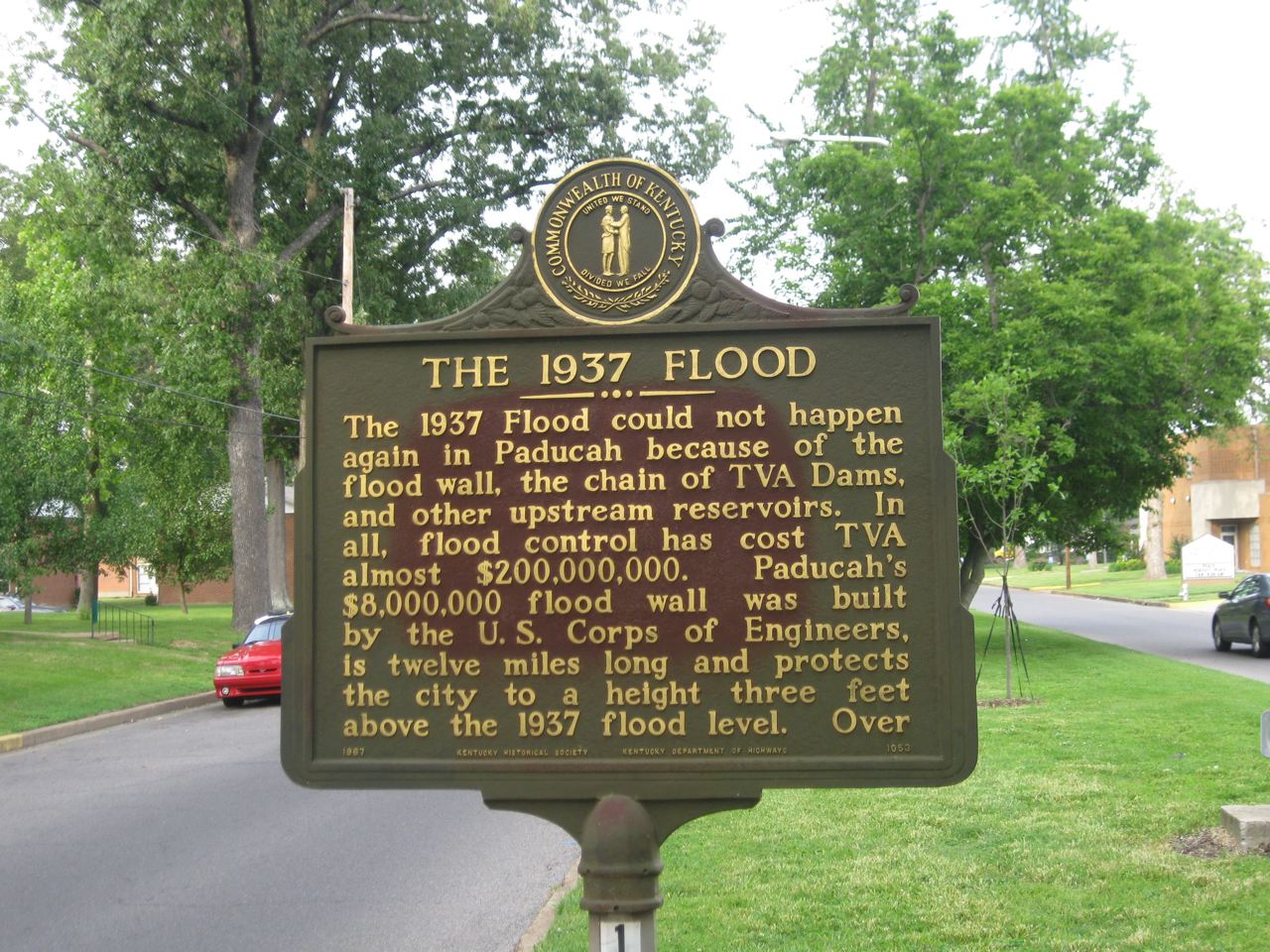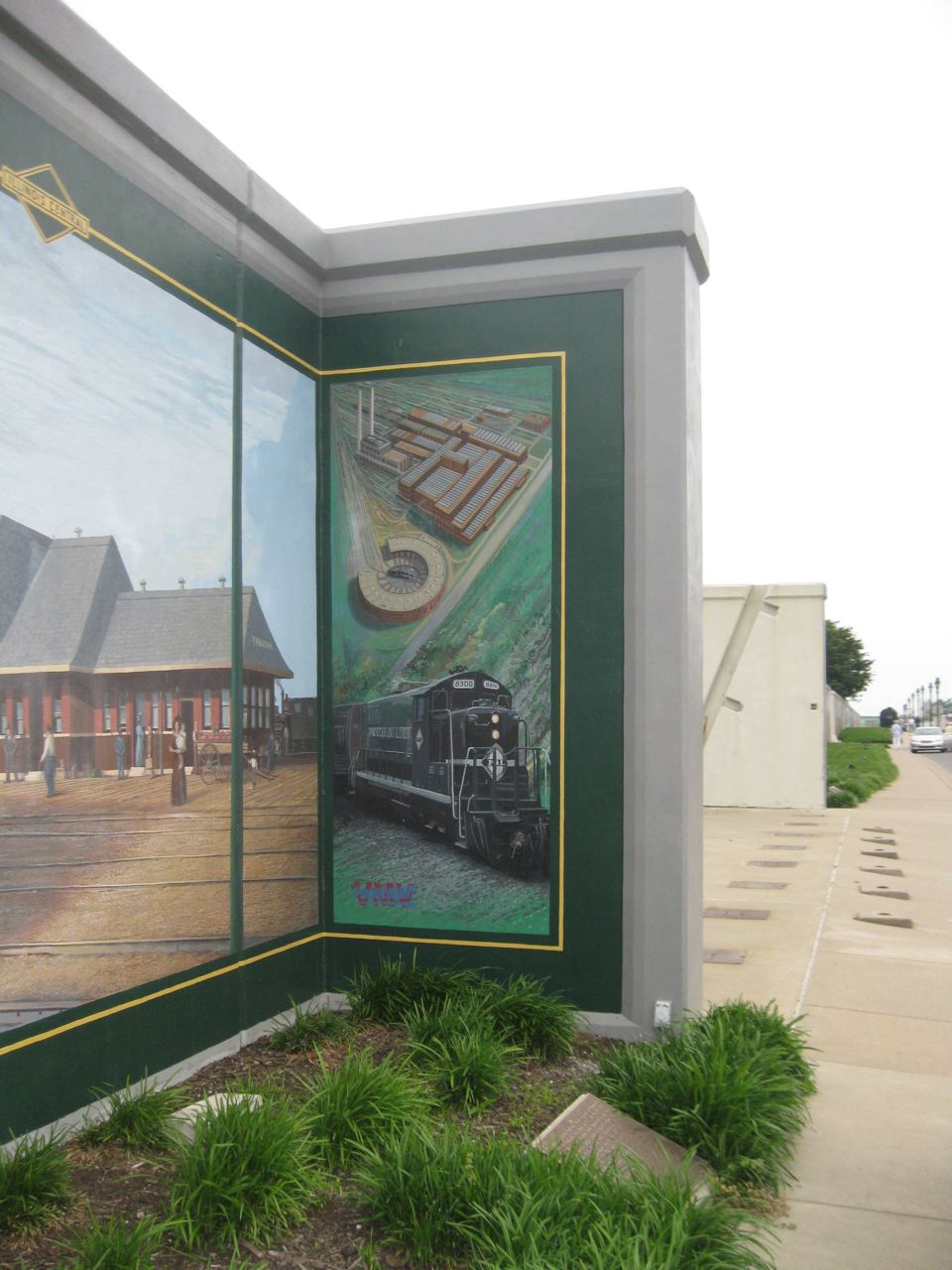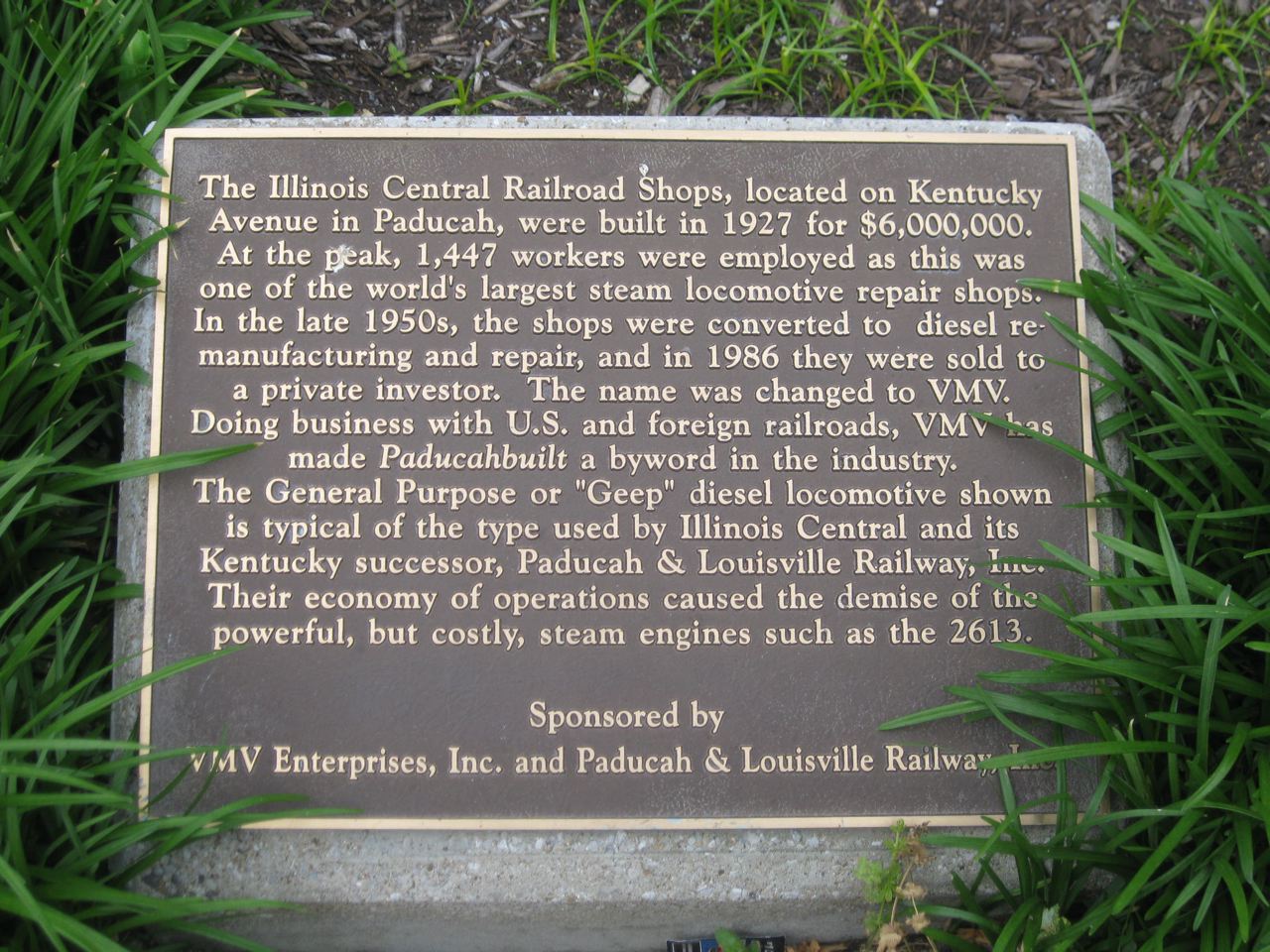Paducah Rare-Mileage Trip
May 20-23, 2011
Photos by Dave Ingles
| When High Iron Travel announced a charter special from St. Louis to Paducah, Ky., to Chicago, via Galesburg, I signed up immediately because the BNSF, former CB&Q, line from Paducah to Galesburg went thru Jacksonville, Ill., where I went to college at MacMurray during 1962-1965, and I hadn't ridden that segment. The trip attracted a "big" crowd of mileage collectors, over 30, for its rarity, even after having to be postponed a couple of weeks because the UP had flooding problems in southern Illinois. UP has done a 180 on allowing Amtrak-affiliated special trains, so the trip would use UP from St. Louis to the BNSF north of Paducah; the original route was to be CN/IC, but CN nixed it just because it's a mean outfit. (On a personal note, I didn't need the CN-IC, since I'd ridden the sleeper on IC's Panama Limited from Memphis to St. Louis, via DuQuoin, in 1970, but most passengers would've needed that.)
To get to St. Louis, over a dozen of us wound up out of Chicago on Thursday, May 19, on Amtrak #21, the Texas Eagle. This was during a maintenance period for UP on the normal ex-GM&O Amtrak "Lincoln Service" route, whose local trains were being served by buses. The Texas Eagle was again using the former C&EI route of UP to detour again, a route some of us had ridden in summer 2010 (see my 2009-2010 Web site page for some photos of that trip). |
| We begin with one of the first photos I made on this trip, Thursday night of #21 at St. Louis after we arrived at the fairly new Gateway Station, which serves Amtrak, intercity and local buses, and Bi-State's light-rail, adjacent on its east side. We arrived about 90 minutes late at 906 pm after incurring two delays in the Chicago area, at 80th St. (BRC delay) for 42 minutes and Thornton Jct. (broken switch frog ahead on UP had to be inspected) for 51 minutes. Of note is that we ran non-stop thru Villa Grove without stopping to change pilot crews. We had no other delays, or stops, and had left Chicago on-time at 145 pm. |
 |
| Next morning is was cloudy, but this would be one of the few opportunities for a trackside view of our train with Amtrak power, since Amtrak generally doesn't allow photo runs on these specials. Some hosts road will allow it, but we had none on this trip acct. either a tight schedule or other restrictions. As it did on the L.A.-Bakersfield excursion in early April, Amtrak made sure one of its "Heritage" P42's led our train, this time No. 184. Trailing unit is No. 19, and the consist is ex-UP 10&6 sleeper Pacific Union, ex-Frisco 14&4 sleeper Cimarron River, ex-NYC 6-bedroom-lounge Swift Stream (serving as our diner), and PV Caritas, with an open rear platform. The bedrooms in Pacific Union were not sold and served as our lounge areas, with bar service. Originally ex-ATSF full dome Scenic View, ex-Nenana from its Alaska tour service, was to be in the consist, and would've served as lounge, diner, and viewing dome, but the postponement of this trip conflicted with another outing for the dome, two weekends of Chicago-Quincy trips on Amtrak's Carl Sandburg for riders to bus down from Quincy to Hannibal to tour the Mark Twain attractions. |
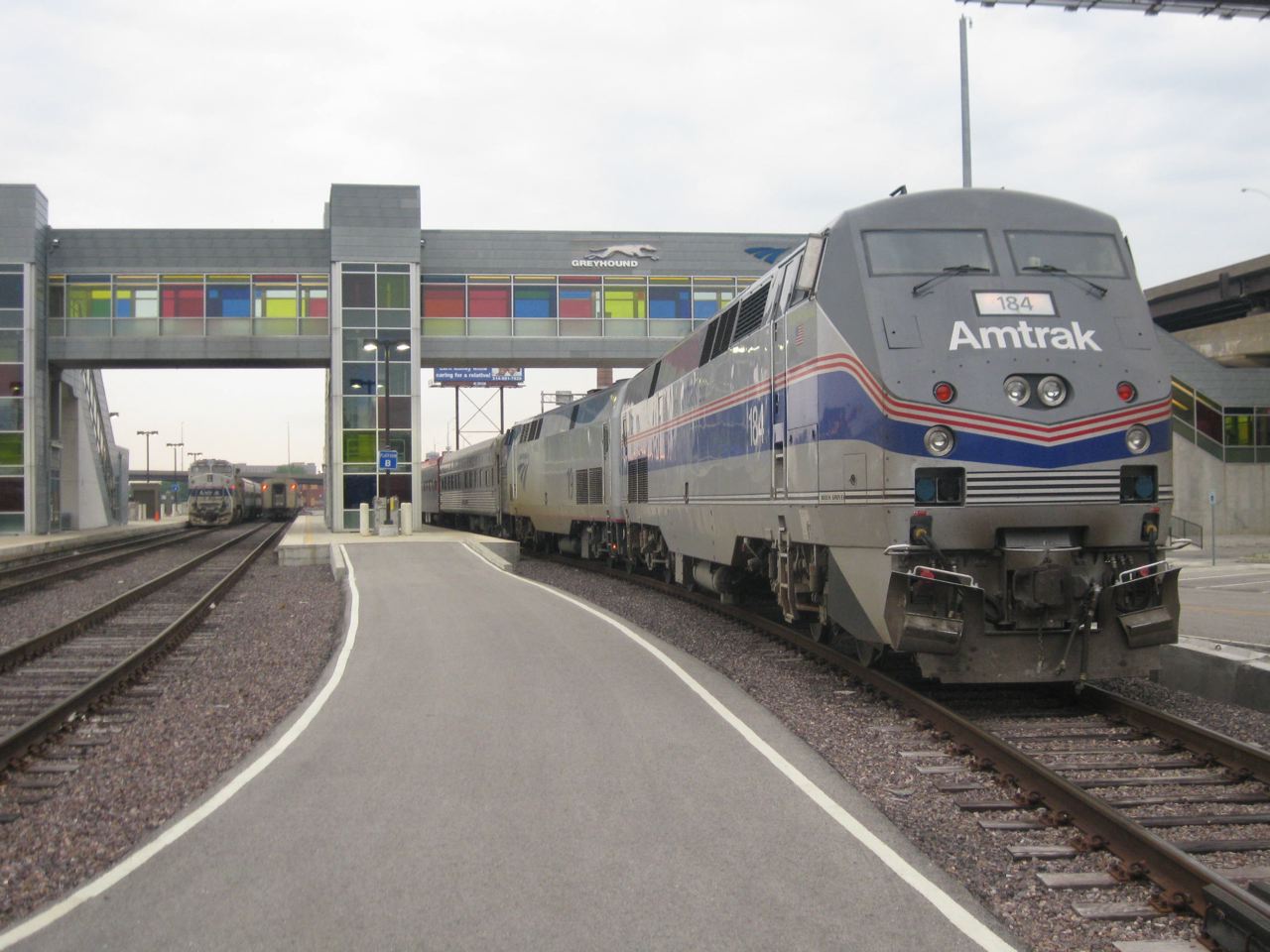 |
| The bus at right is loading passengers for Lincoln Service points en route Chicago. The station would not allow Amtrak's charter bus to dock at the normal bus platforms -- so much for intermodal cooperation! |
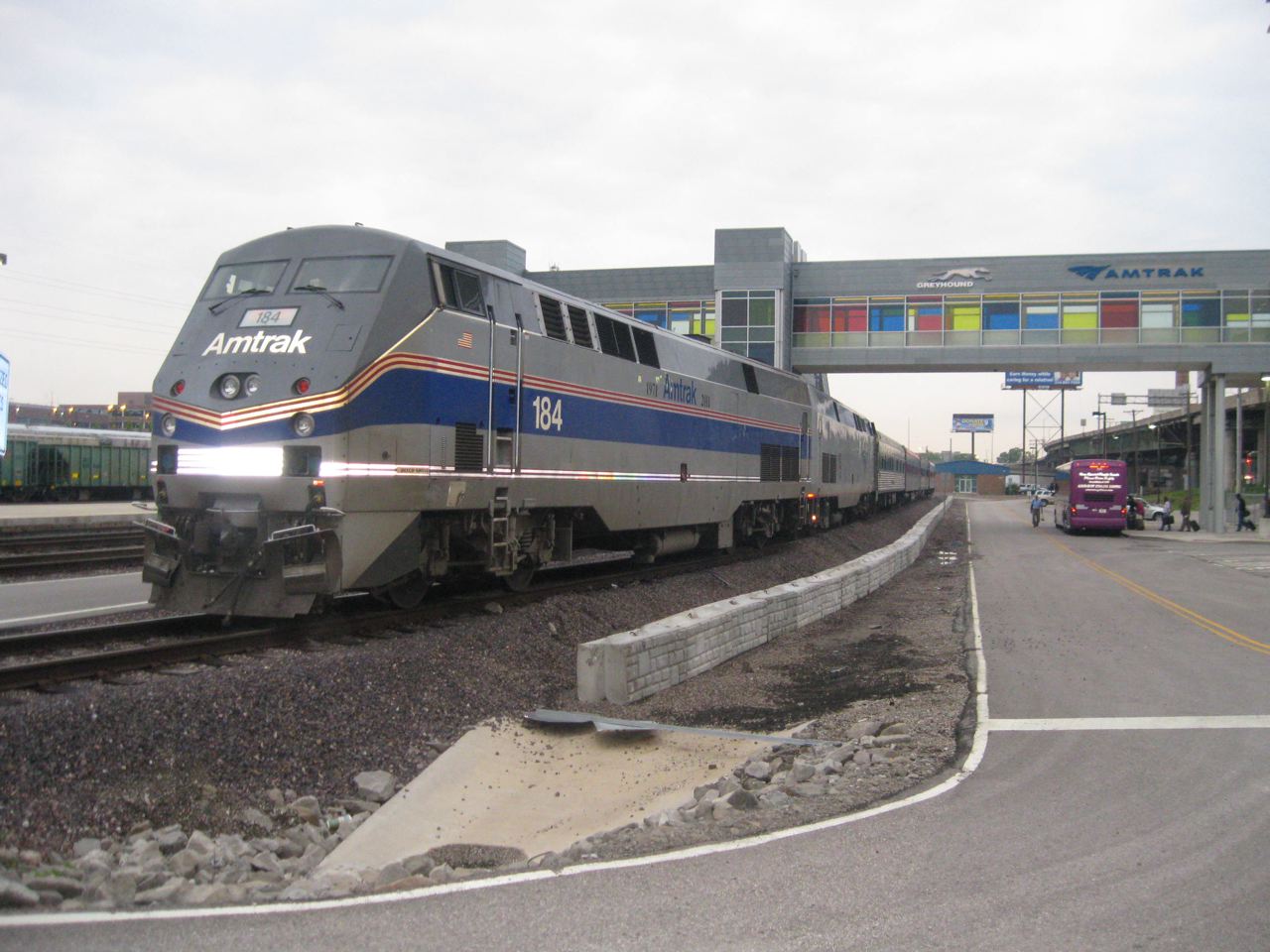 |
| This shows an eastbound light-rail leaving for Illinois from the Gateway Station platform. |
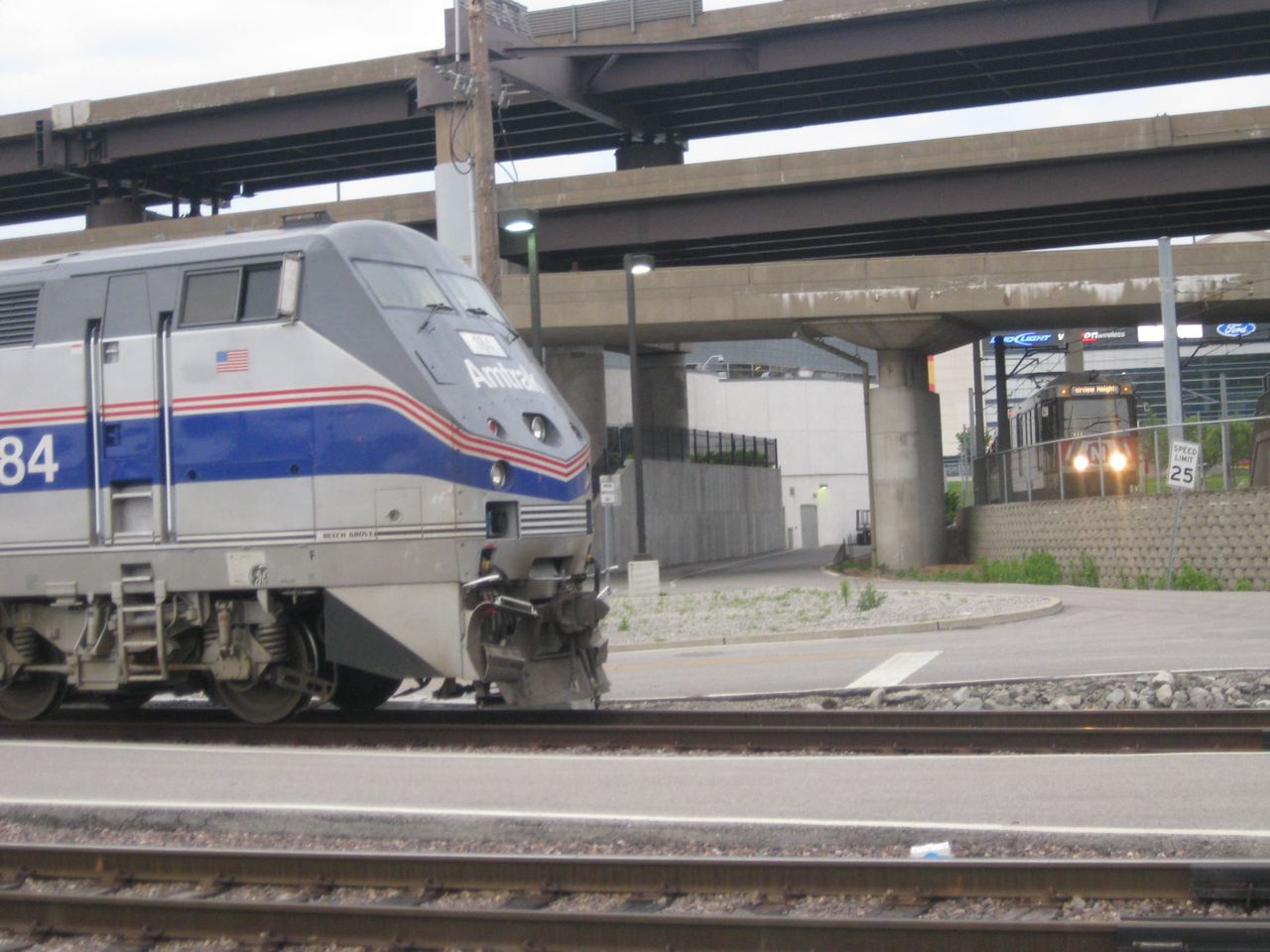 |
| A westbound light-rail swings round the curve approaching Gateway Station platform. |
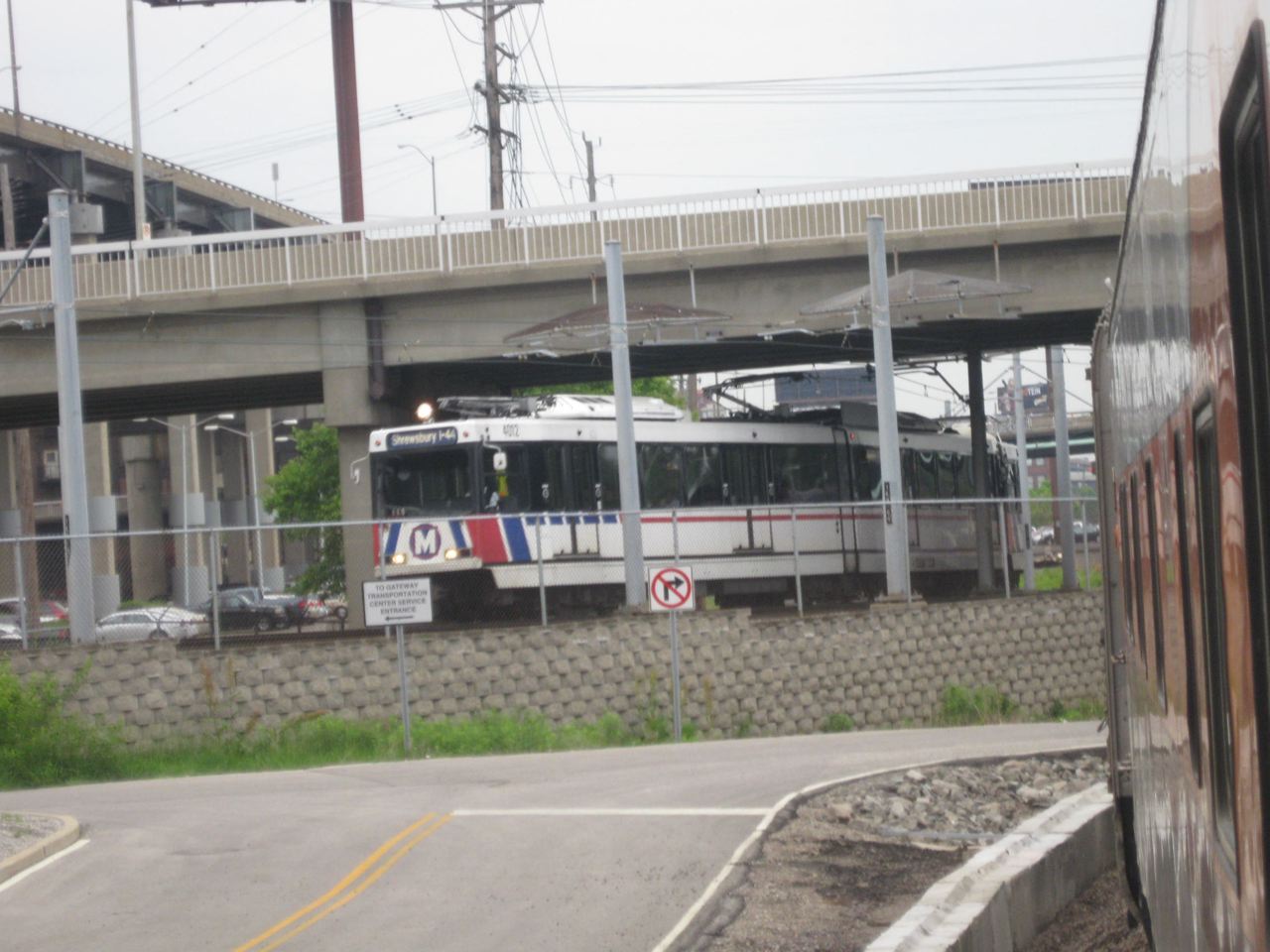 |
| As we pulled out of Gateway at 723 am (schedule had been 700 am), this UP coal train was getting its engines fueled. |
 |
| On to MacArthur bridge over the Mississippi we go. |
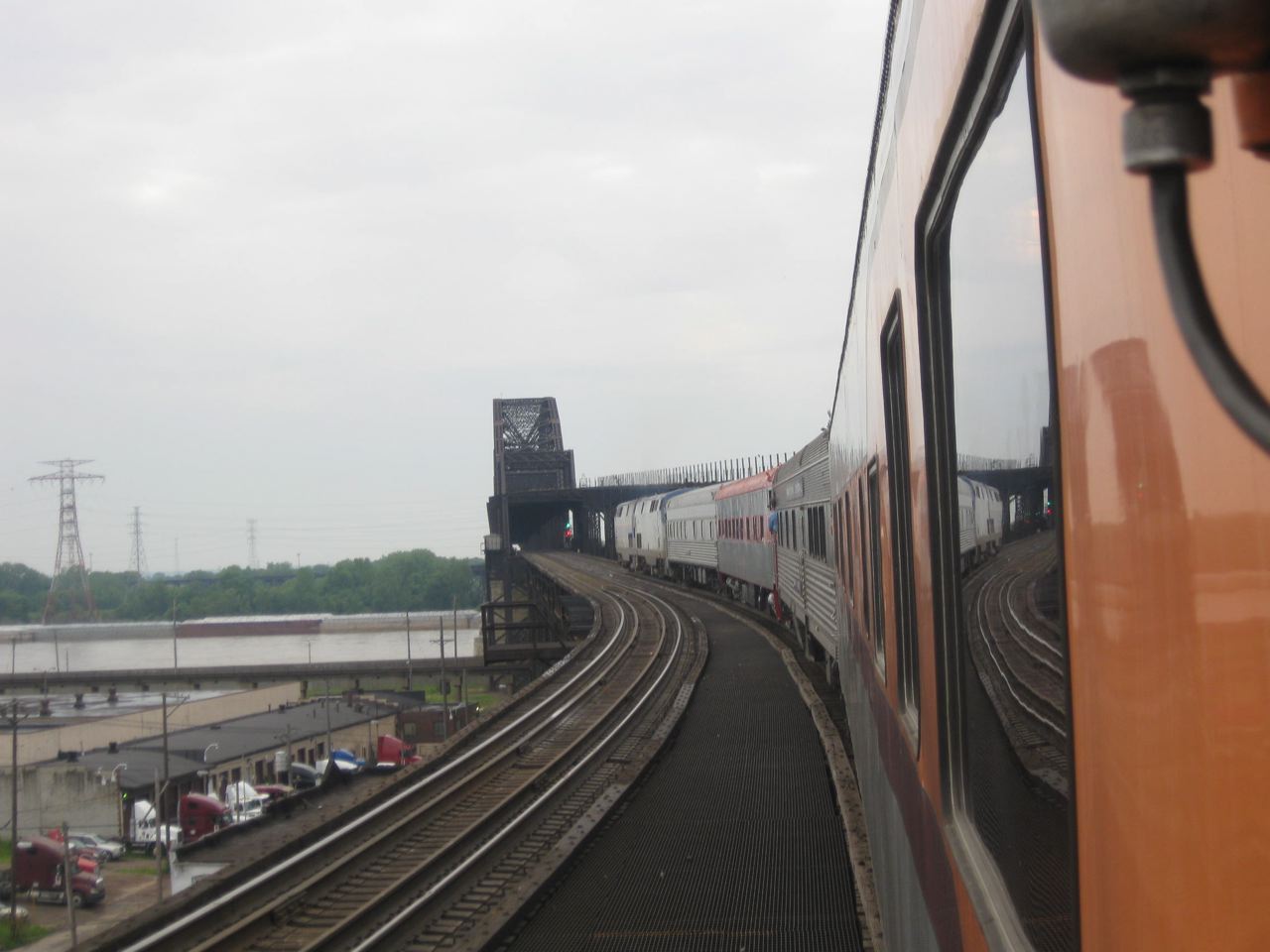 |
| To the north, I-55/64 and the Gateway Arch. |
 |
| Now onto freight-only trackage, at least since Amtrak's River Cities quit running. |
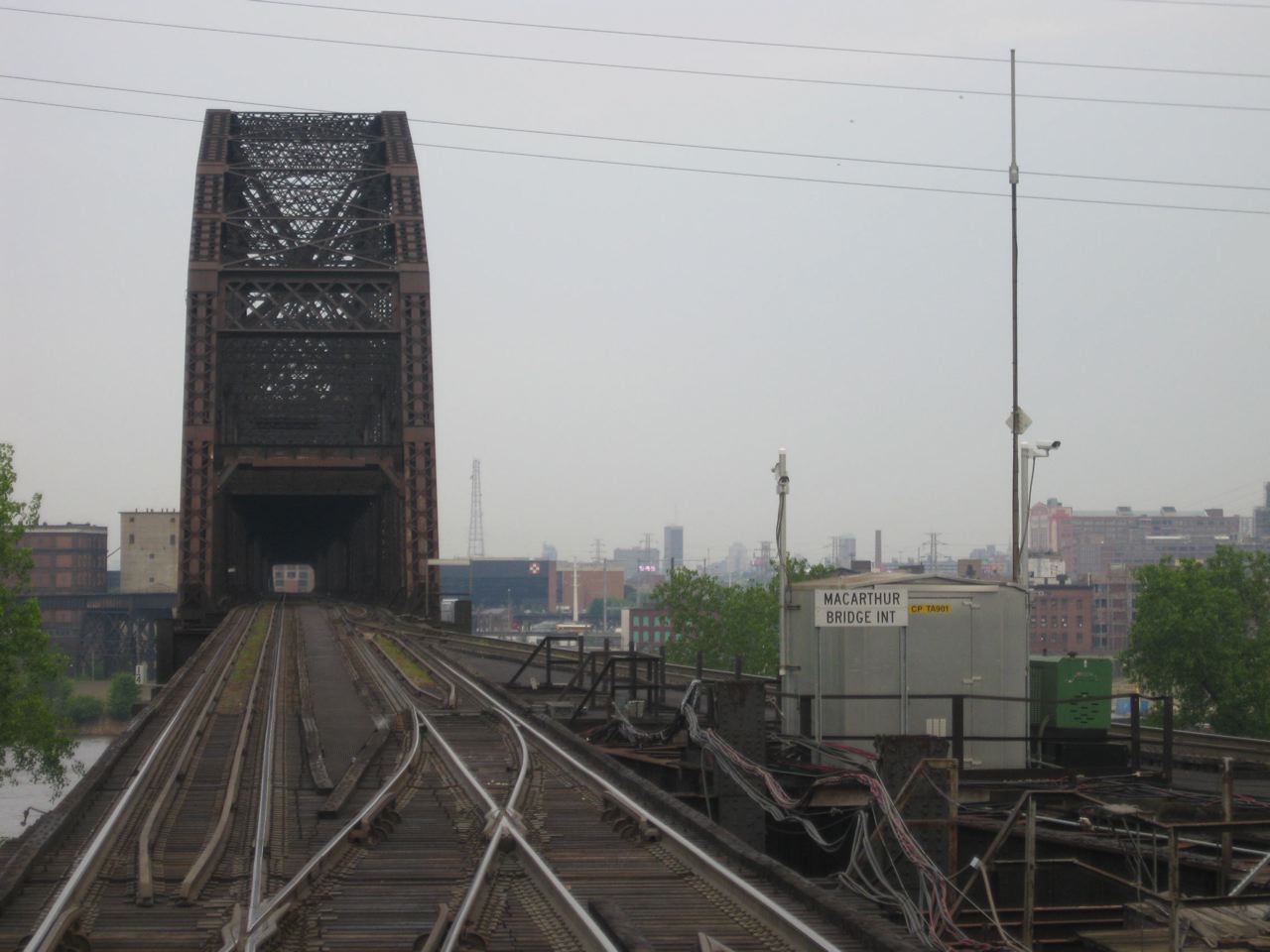 |
| Down the approach toward Valley Jct., Ill. Beyond the engines is Alton & Southern's Gateway Yard engine terminal (see following photo). |
 |
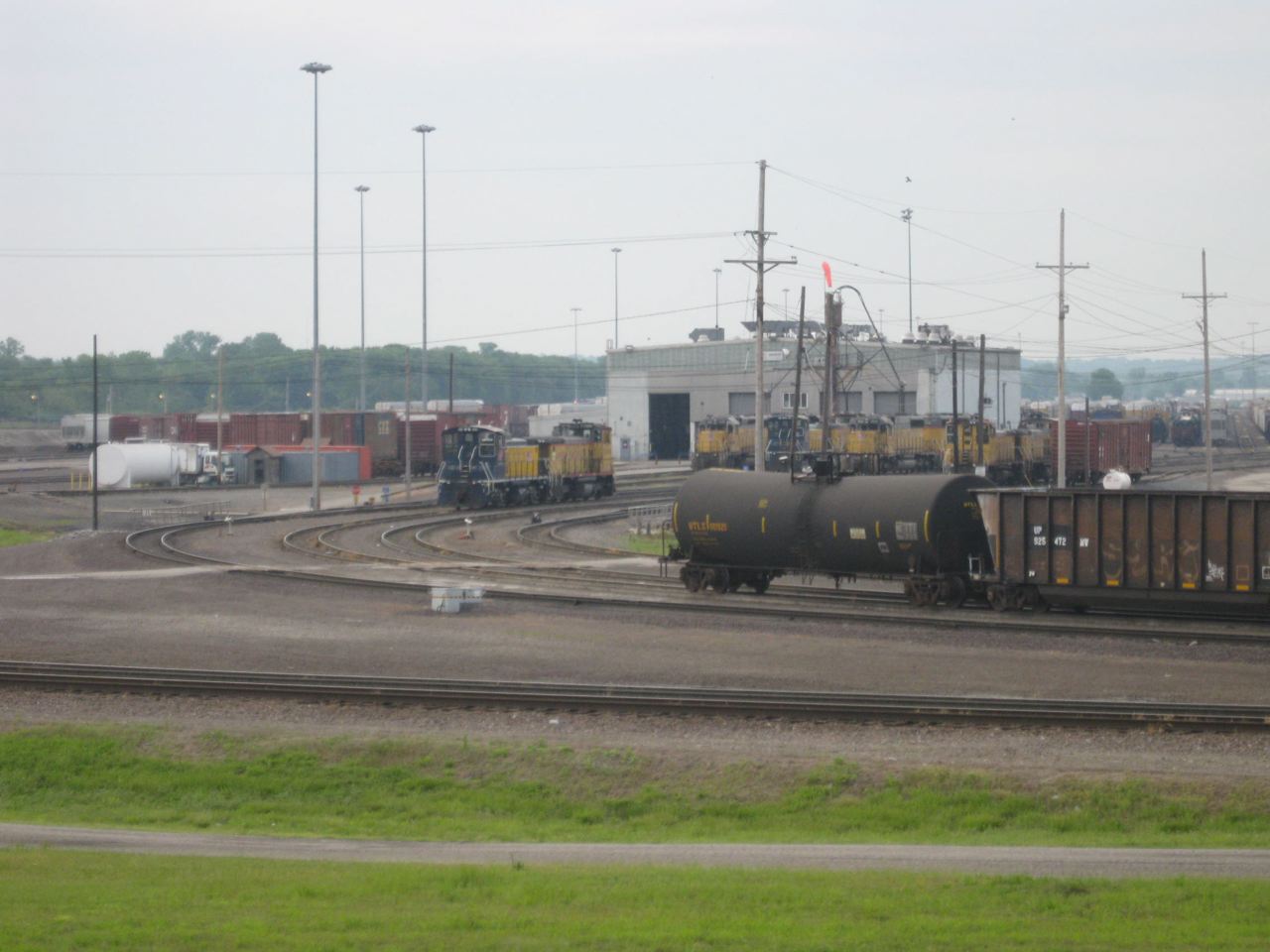 |
| At Valley Jct. itself, a UP coal train is behind us. We will take the former MoPac-Cotton Belt joint main line of UP, down the Illinois side of the Mississippi, to Gorham, IL. The original plan had been to diverge at Chester and go to Mt. Vernon to connect to the former C&EI, then southward thru Benton toward Paducah, but a tour of VMV's ex-IC Paducah locomotive shop was scheduled for the afternoon, so the faster route was chosen, to Gorham on the main line, then the UP main Chicago-Little Rock freight route, an ex-MoPac branch, over to Benton, and then south on the former C&EI. |
 |
| At Flinton, Ill., two southbound UP freights, each led by Ferromex units, were staged. |
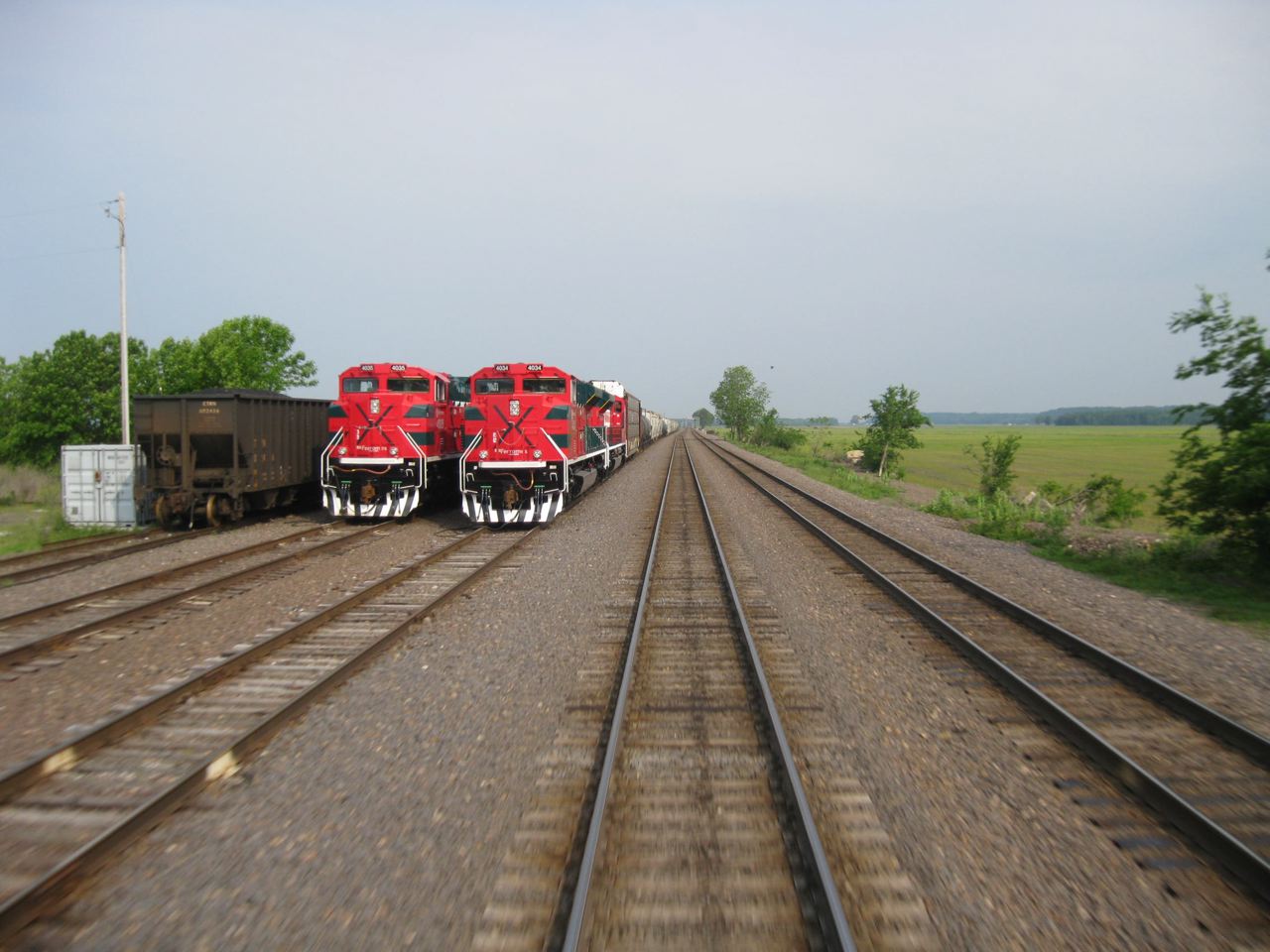 |
| Just past Flinton, a northbound freight flashed by. |
 |
| South of Chester we begin to see evidence of the high Mississippi River water. |
 |
 |
| Now east of Gorham, we fly over the IC main line at DeSoto, Ill., at 1006 am. |
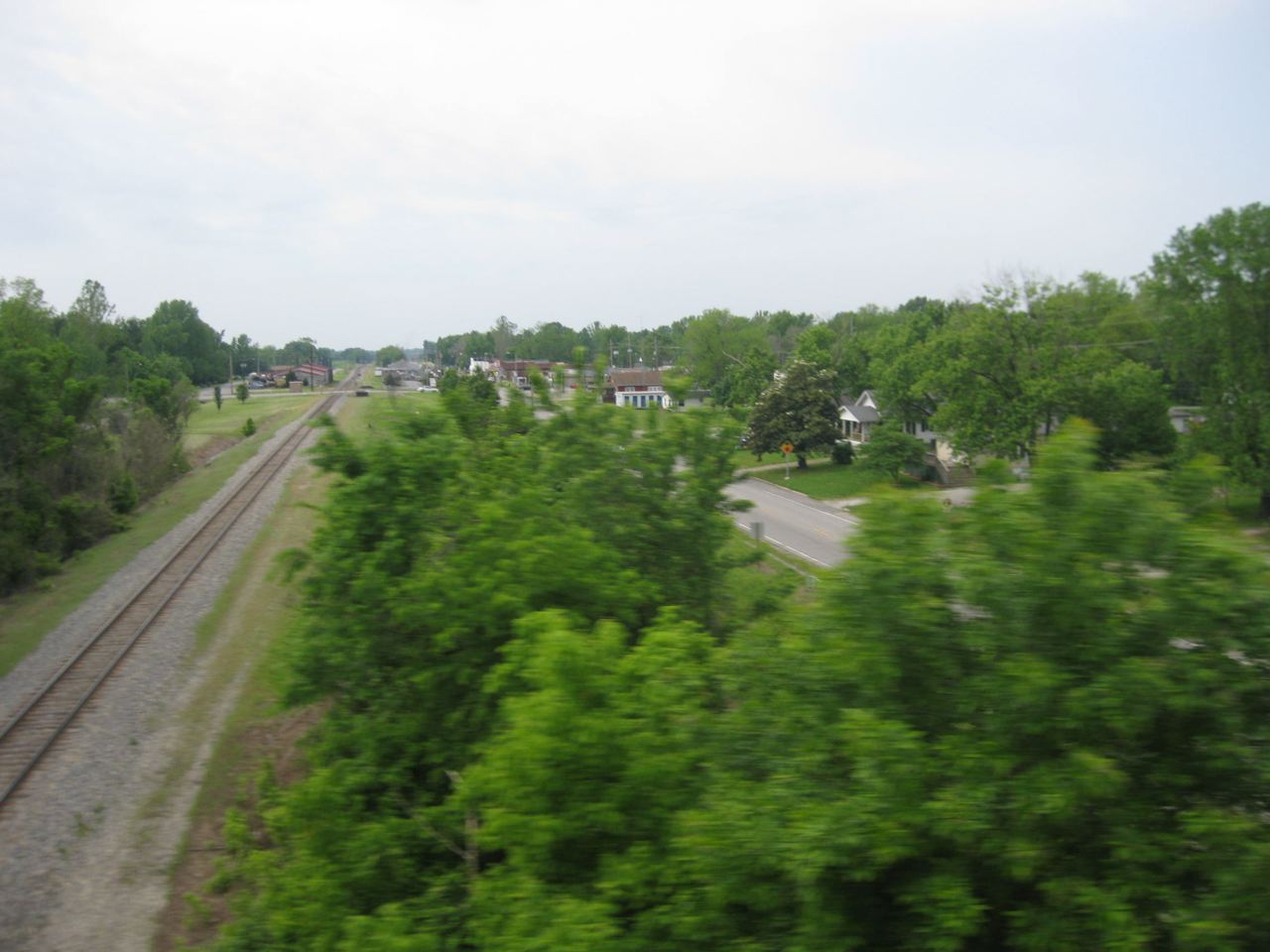 |
| Curving around at Benton Jct., Ill., onto the ex-C&EI southern Illinois line, 1032 a.m. |
 |
| Looking back at the depot at Johnson City, Ill. 1047 a.m. |
 |
| And at Marion's at 10:55. This C&EI line's final passenger service was the Chicago-West Vienna, Ill., "Meadowlark," in its last years an RDC-1, C&EI's only RDC. The run was discontinued in the early 1960's. |
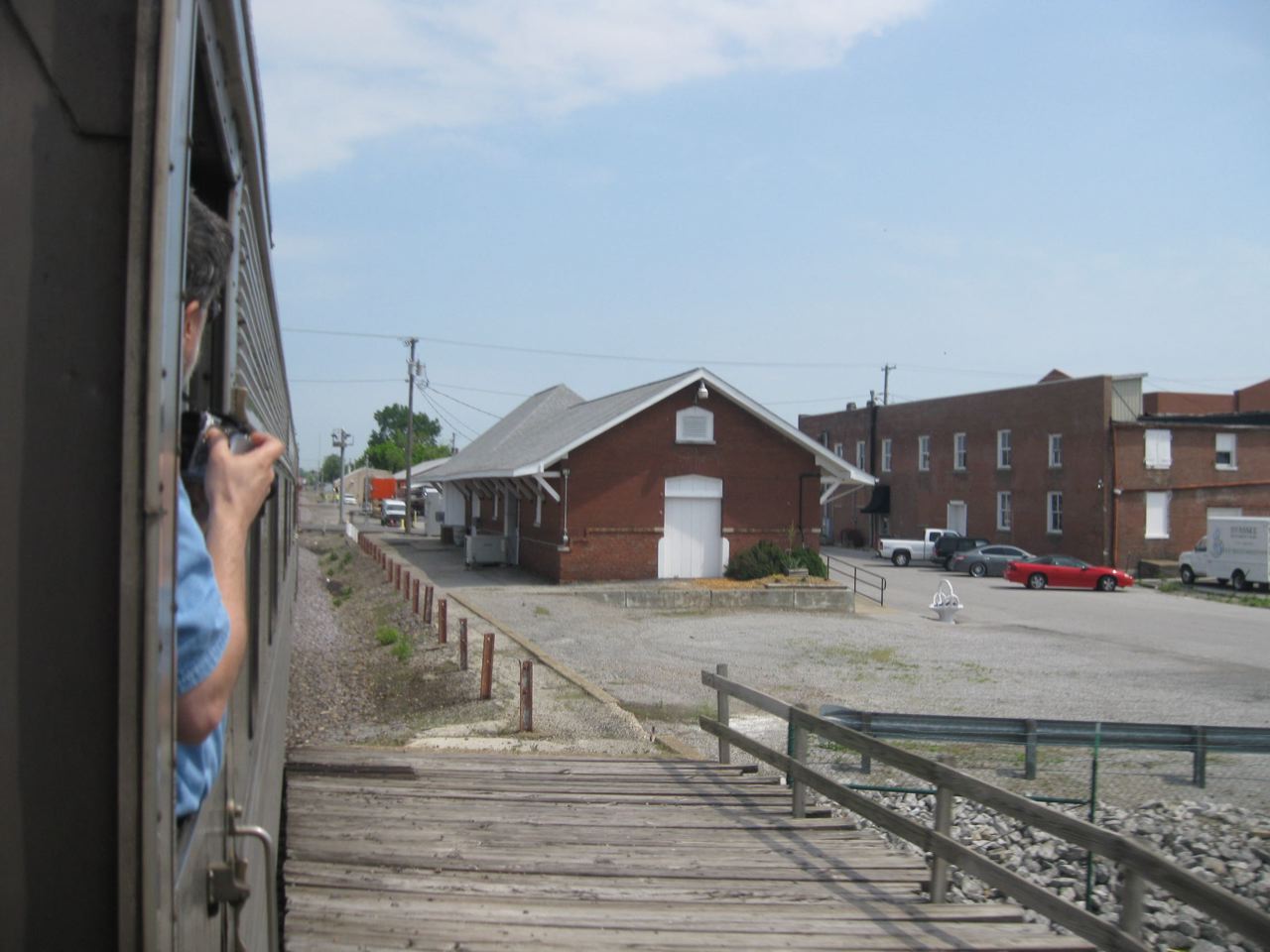 |
| Now on the old CB&Q south of Neilson Jct. and Vienna Jct., we look back to see our way had been cleared (OK, it probably was for a coal train). CB&Q joined C&EI at Neilson, ran on C&EI trackage rights to West Vienna, aka Vienna Jct.; each junction had a C&EI white wooden interlocking tower. At West Vienna, CB&Q diverged southeast to Paducah, while C&EI continued south to Thebes, Ill., on the Mississippi River, with a branch to Joppa, on the Ohio River, where it had a coal transloader. That facility still exists, but the old C&EI is gone south of West Vienna. Instead, C&EI successor UP has rights on CB&Q successor BNSF to a new Joppa Jct., from which a BNSF branch goes to the Ohio River transloader. Nowadays, UP has rights into Paducah proper, as does CN, meaning Paducah is served by CN, BNSF, UP, and Paducah & Louisville. |
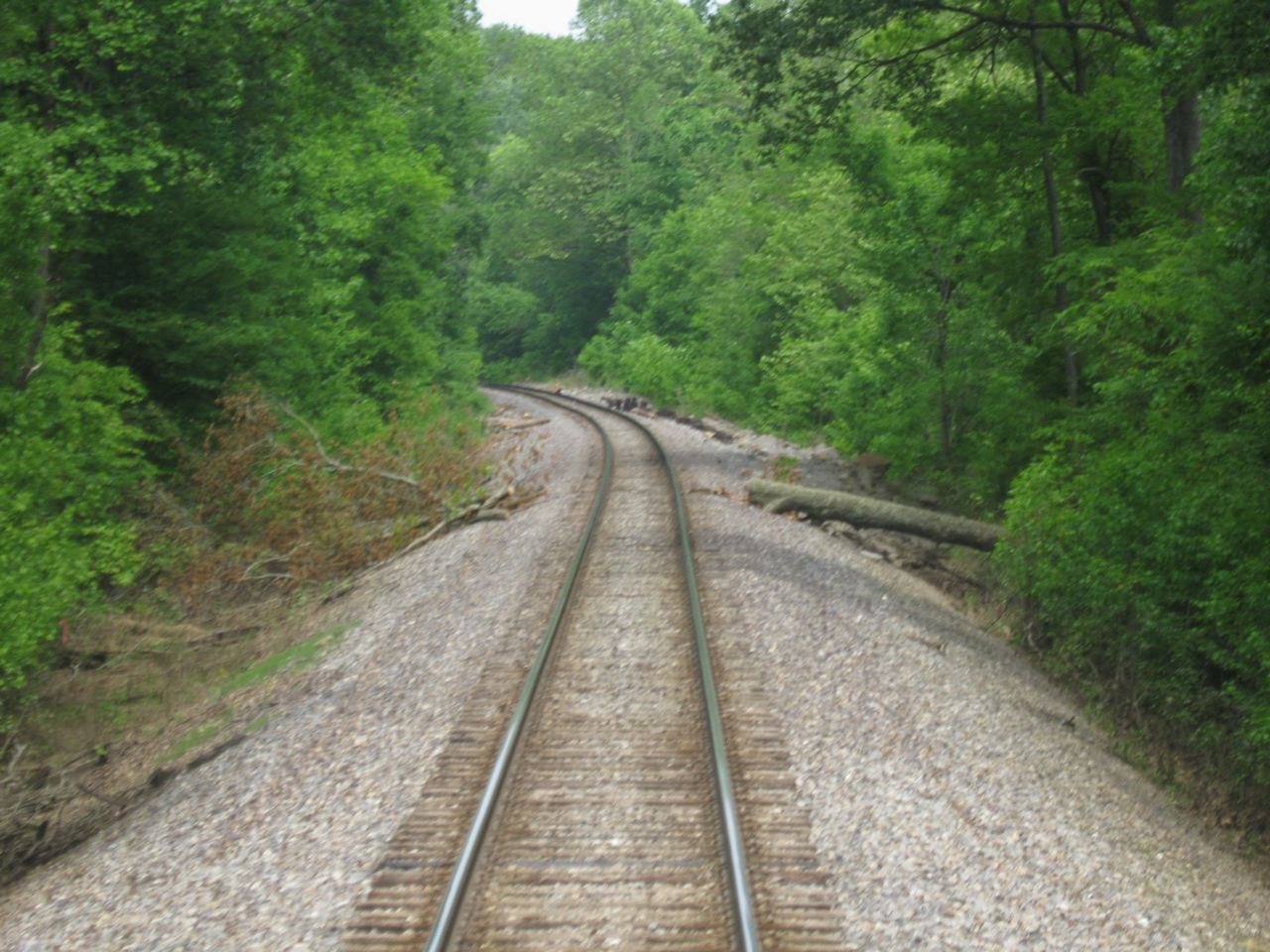 |
| This is Forman, Ill., looking north. The recreational trail beyond the road crossing is the old NYC Egyptian line, later PC, to Cairo, Ill. To the north of here (to the right) is Tunnel Hill, one of Illinois' few rail tunnels (9 or so), which the trail now goes thru. The 210 Milepost is the old CB&Q mileage from Concord, Ill., north of Jacksonville, where this coal-country and Paducah line diverged from CB&Q's Bushnell-Beardstown-St. Louis line. |
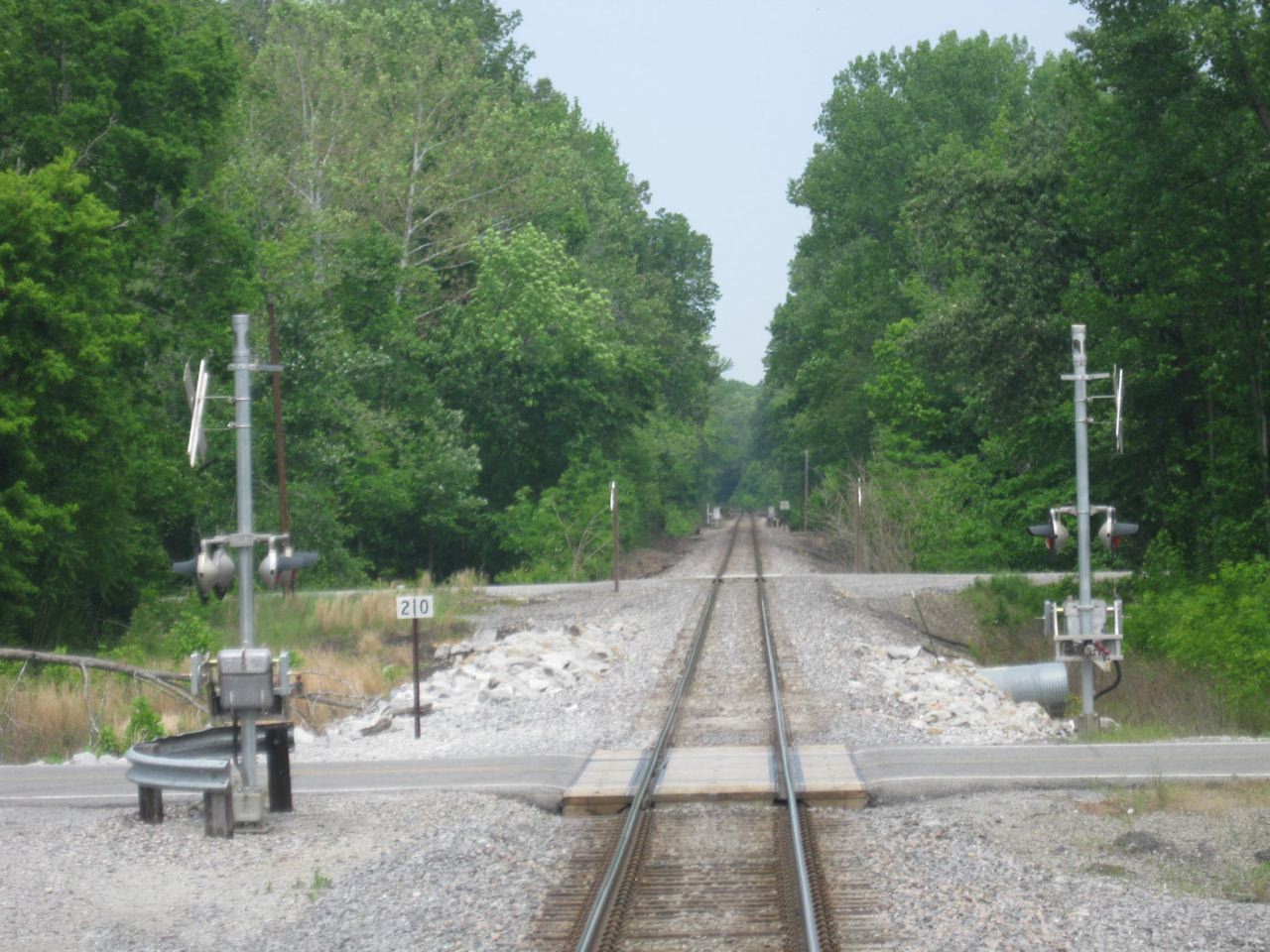 |
| Onto the Paducah & Illinois bridge over the swollen Ohio River. This is the town of Metropolis, Ill., "home of Superman" (the only true "Metropolis" in the U.S.). Paducah & Illinois was created to build the bridge to connect the owners, CB&Q and Nashville, Chattanooga & St. Louis, which did a lot of interchange here. IC at that time had a ferry from downtown Paducah to Brookport, Ill., but when IC built its Edgewood Cutoff (aka Bluford Sub) as its major north-south freight line in southern Illinois, with easier curves and grades than thru Centralia and Carbondale and Cairo, it bought in to the P&I and became the bridge's major user. Today BNSF, UP, and CN use the bridge, UP on rights into Paducah proper for interchange with Paducah & Louisville. PAL owns the ex-IC yard and the line to Louisville; CN has rights on PAL into the city's yard. CSX is part owner of PAL, but is out of the Paducah picture otherwise, the old NC&StL/L&N branch long since torn up (1960's I think). Note the sandbags at lower left, piled up from having protected homes from the flooding in this area of town. |
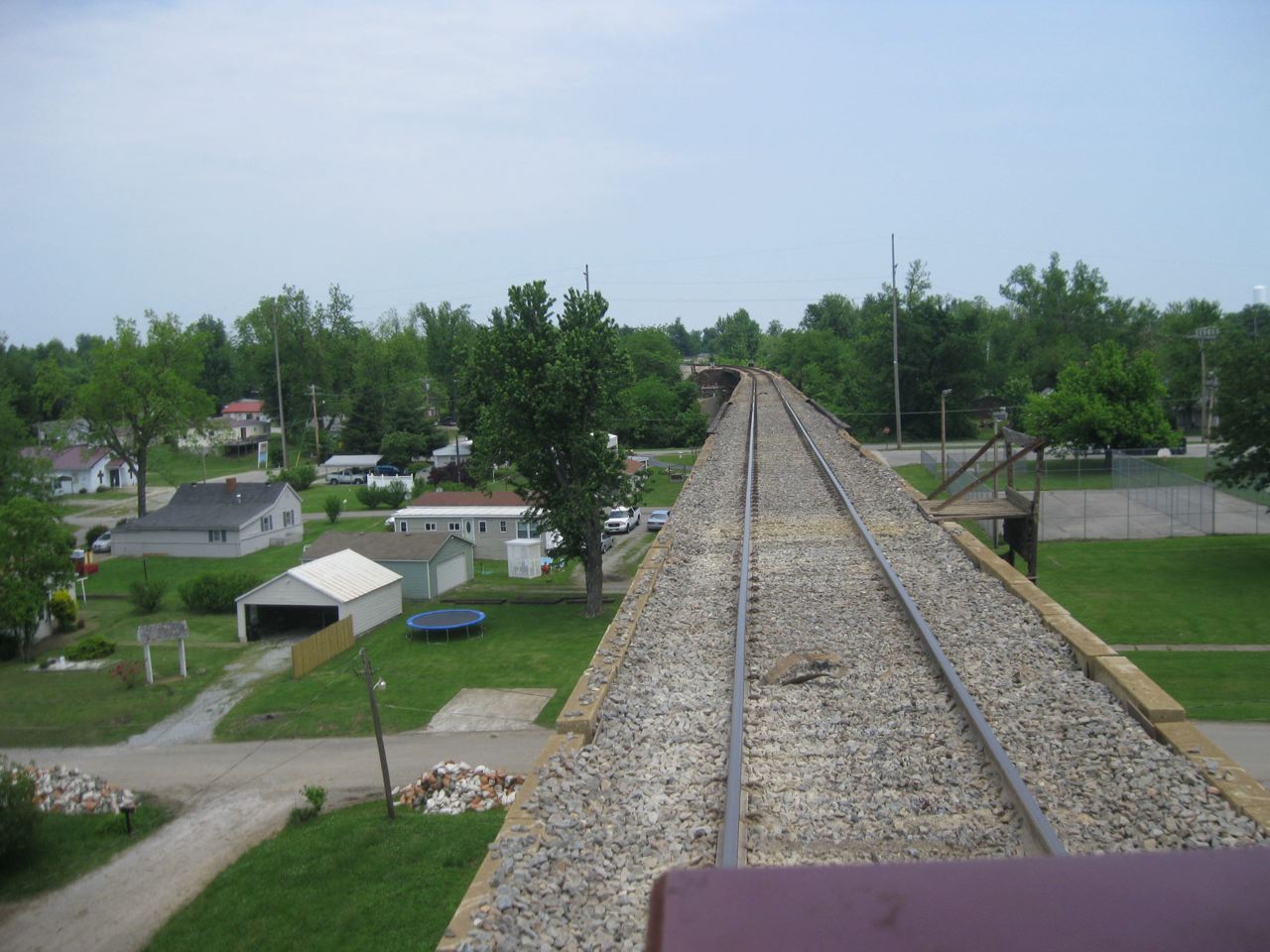 |
| Note the high-water mark on this Metropolis home, from this year's flood. We would tour this part of town on Saturday in a rental car. |
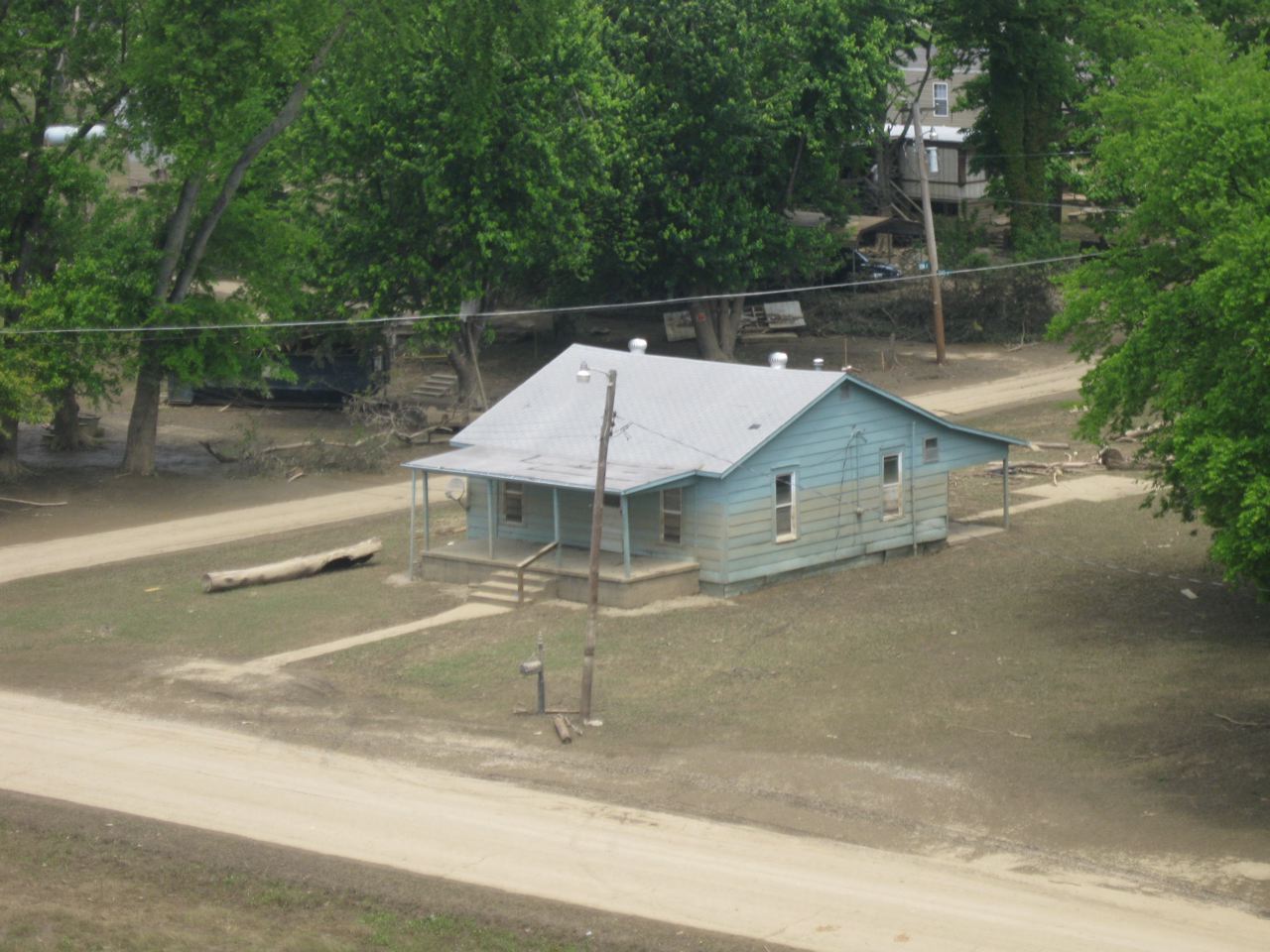 |
| The now-unused Metropolis city spur of BNSF (ex-CB&Q), but mainly to show flood damage to the trees. |
 |
| The Metropolis casino, still closed from flood damage. |
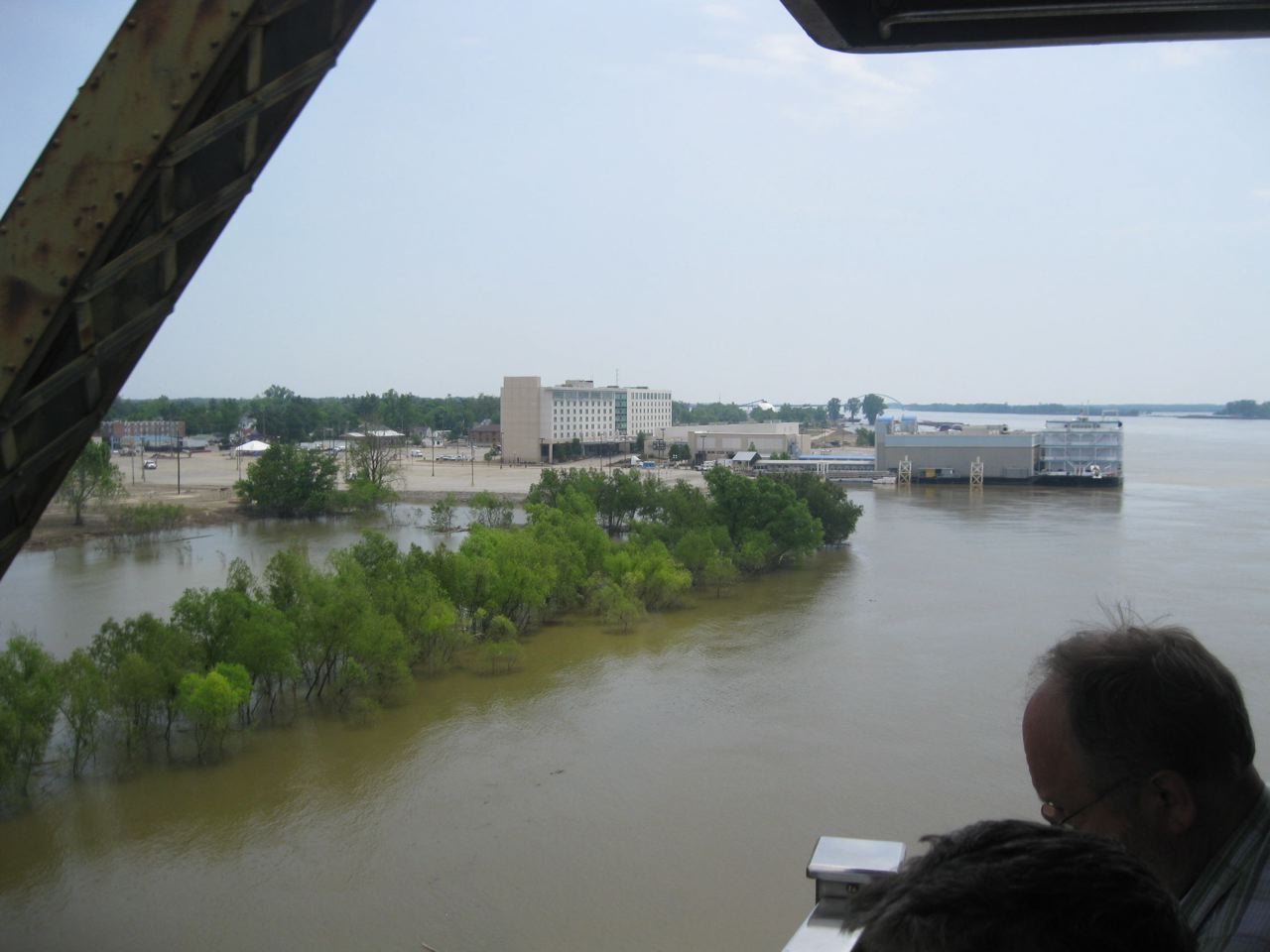 |
| A westbound tow. |
 |
| This is one of the longer U.S. rail river bridges. |
 |
| Leaving the bridge track, but still on P&I; CN-IC main to Fulton, Ky. off to the left. This is Chiles Junction; it's 12:26 pm, where a northbound CN waited for us (see following photo). |
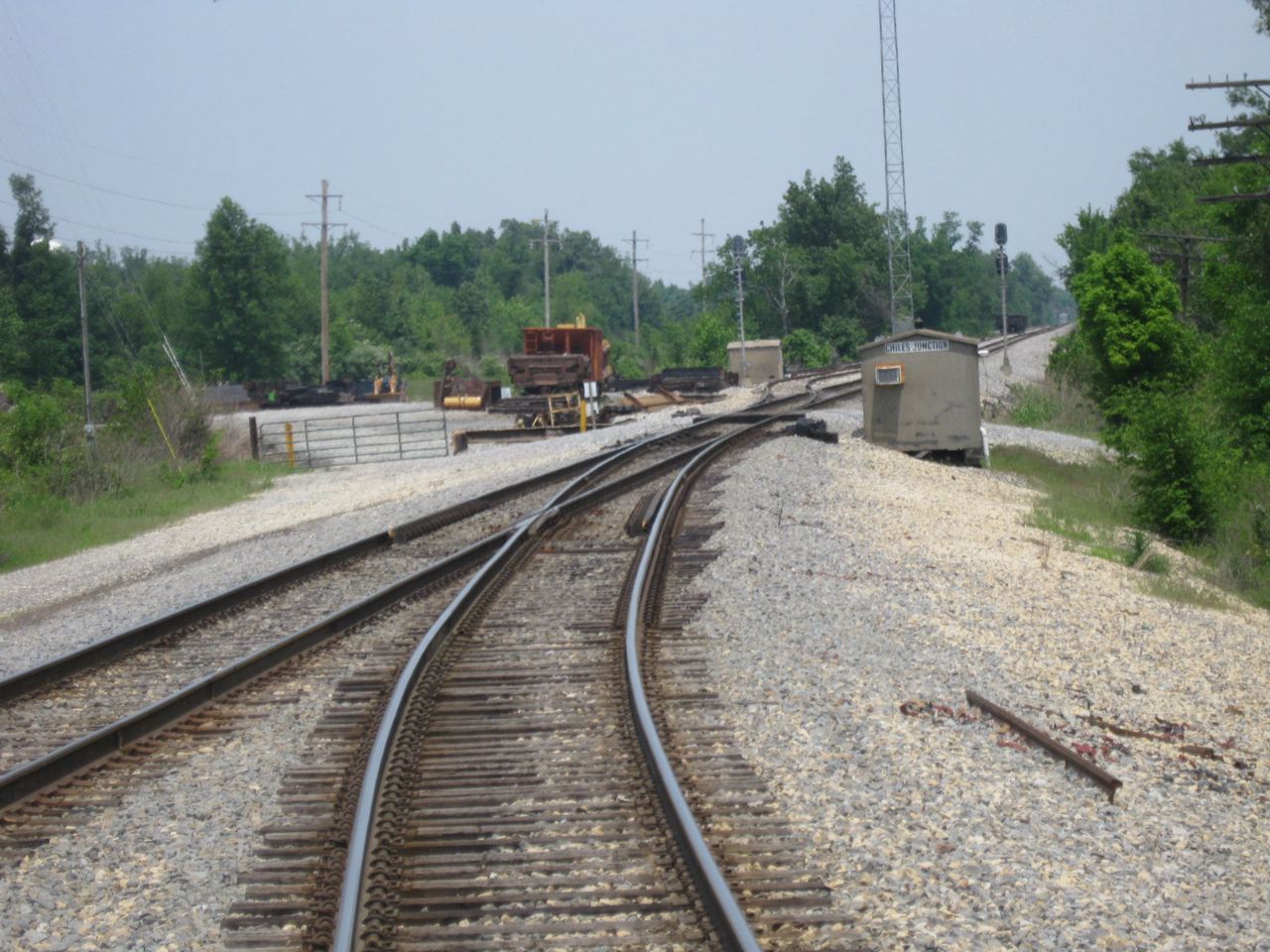 |
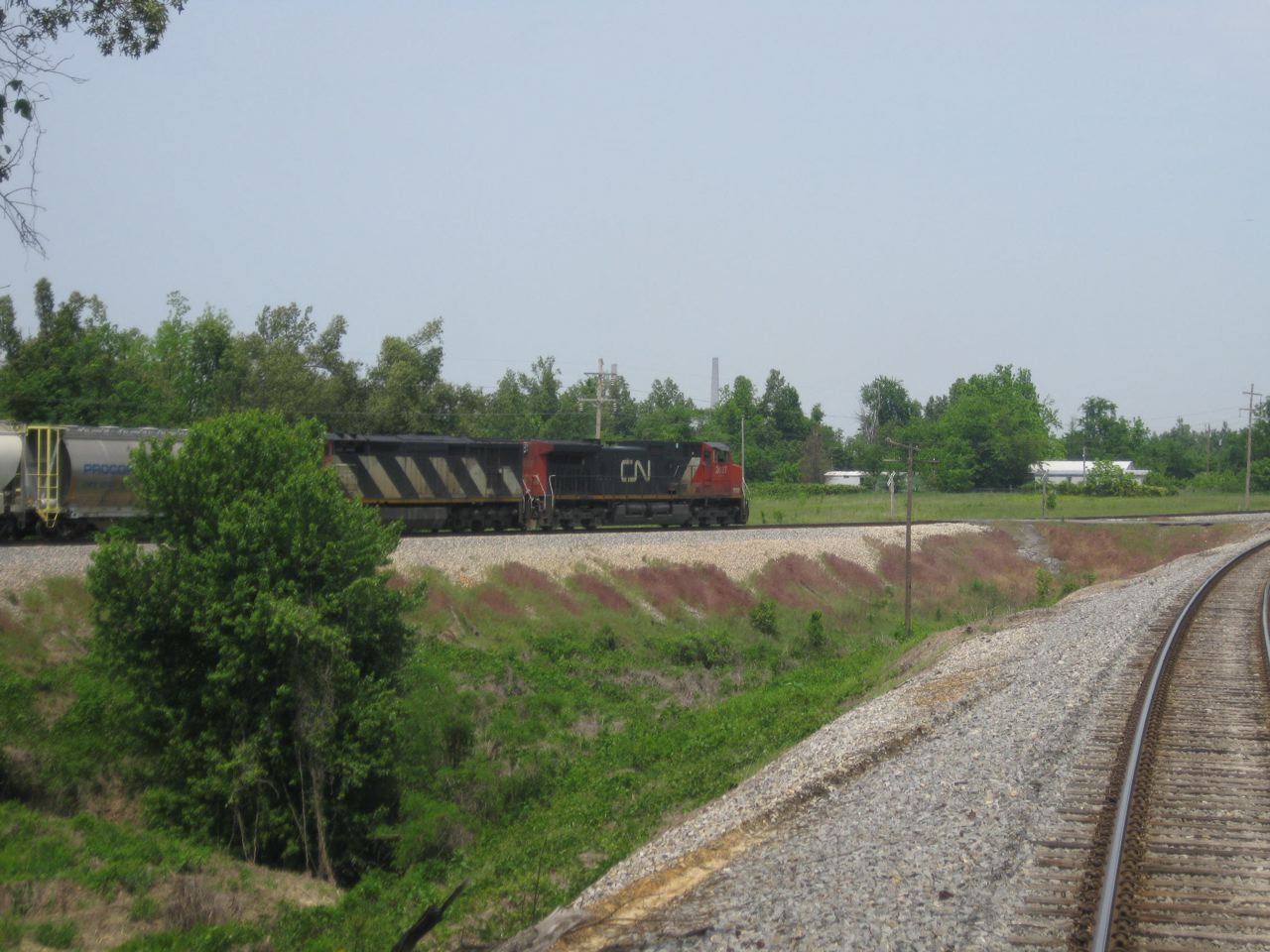 |
| The line into the yard actually passes over its middle, south of the yard office, and loops around north and east to where Union Station was. We then curved on into the north end of the yard. |
 |
| A PAL Geep came by while we parked to remove the Amtrak engines. They went to the PAL engine terminal until our Sunday morning departure. PAL's two specially painted Geeps, for University of Kentucky and Univ. of Louisville, waited on the downtown spur (the old line to the ferry slip decades ago) to pull us into our parking spot for two nights, which was at Kentucky Avenue just east of the big locomotive shop next to the site of the big old IC steam roundhouse. |
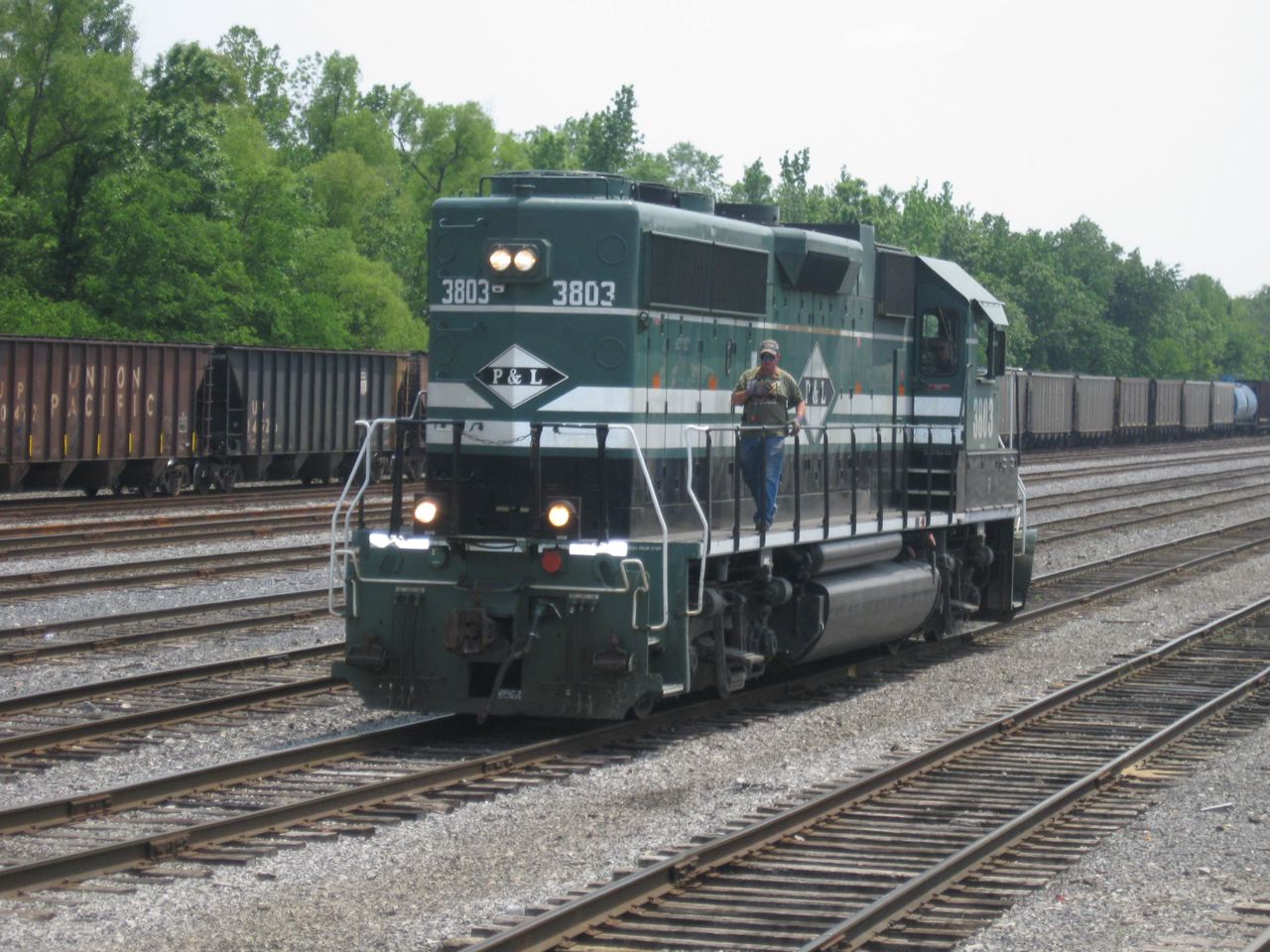 |
 |
| Another UP coal train was in the yard. You can just see the corner of the southerly PAL Geep that came to fetch us. Meantime, those who wanted to tour the shop, which included lunch, were shuttled from here in a van, since we sat here the better part of an hour while folks "played railroad." I skipped the shop tour; it was lots of walking, inside a shop I'd toured for TRAINS in the 1970's as ICG's, and on a humid, 85-degree day. No, thanks. We lunched on the train. |
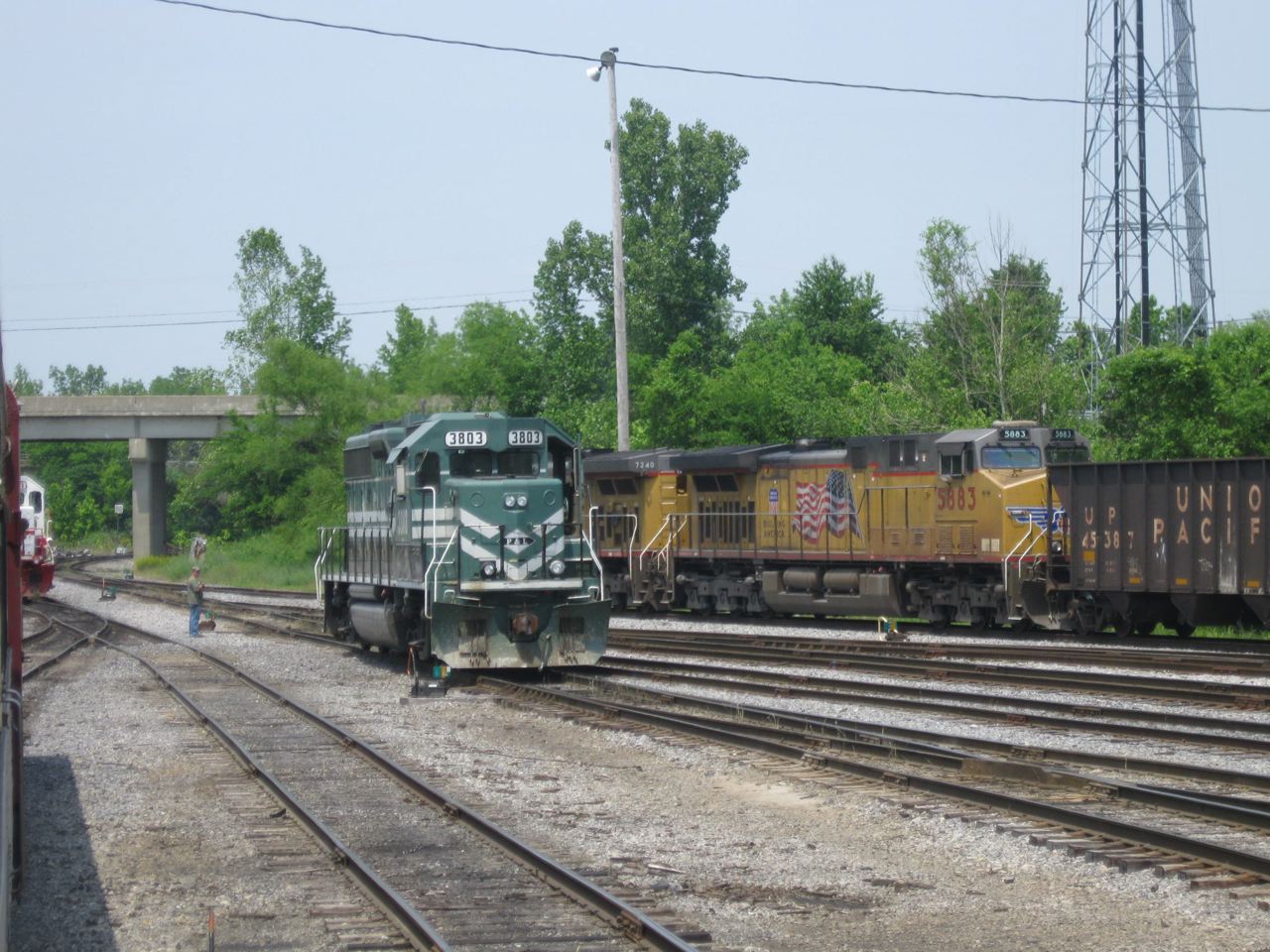 |
| A look at the lines of dead units to the south of VMV's big former IC shops, as we were towed north. |
 |
| The 6205 is an ex-DT&I GP38! |
 |
| We parked at 2 pm, and eventually Phil Moser went to fetch the Enterprise car he'd reserved. |
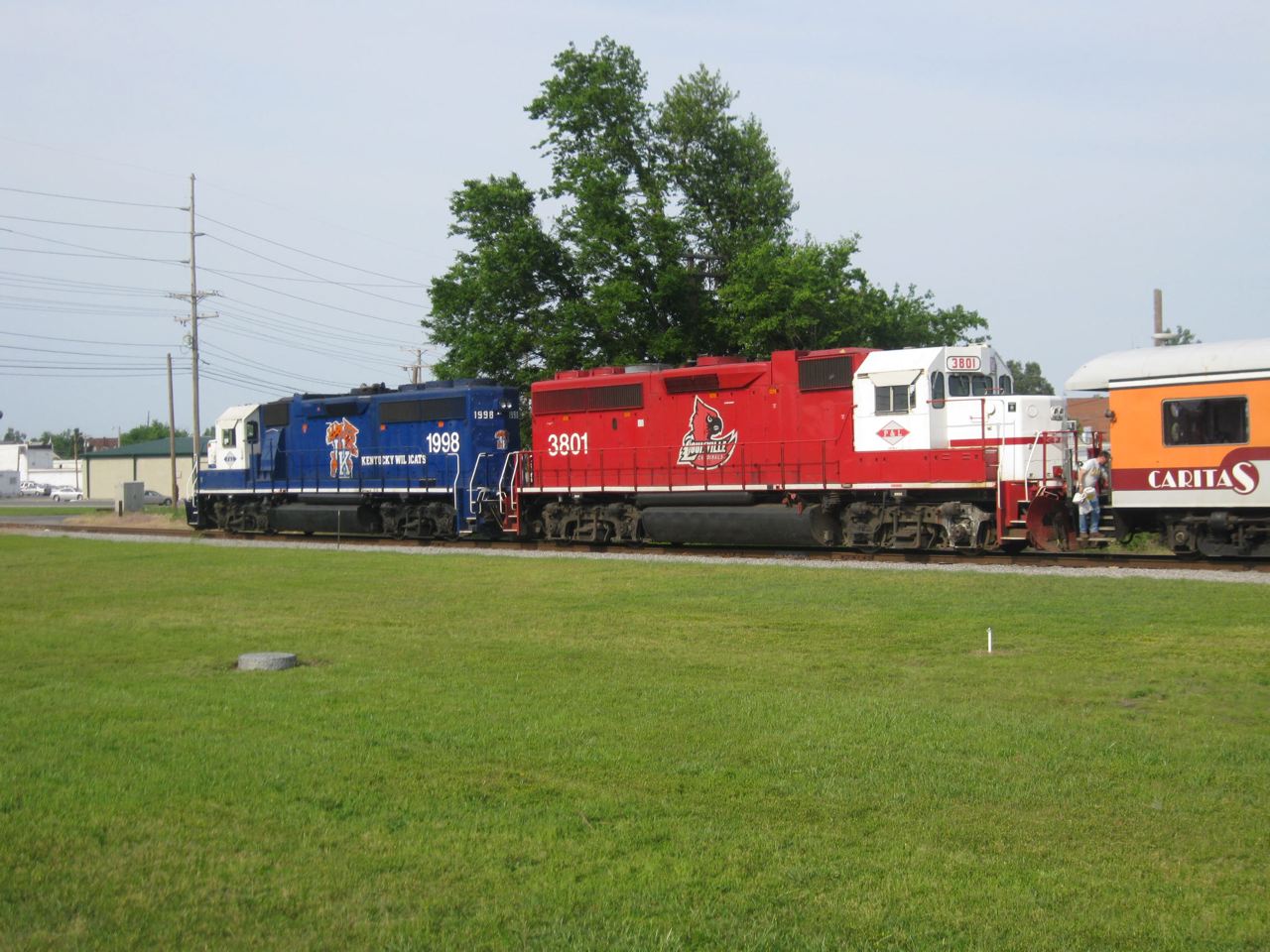 |
| This view of our parked train looks generally south from Kentucky Ave. The UK and UL units are former SP GP60's now considered an upgraded GP38. | ||||
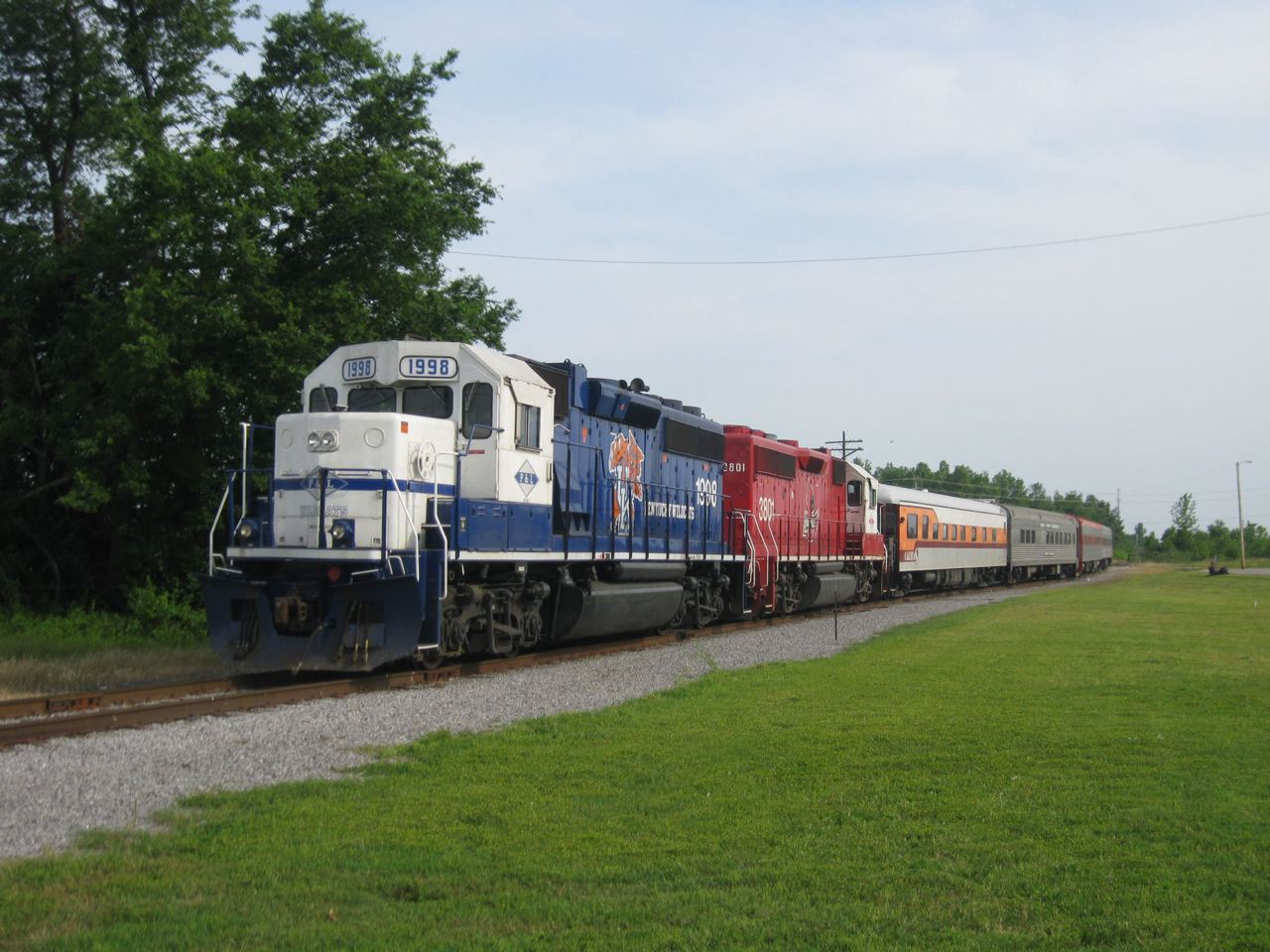 |
||||
|
| After Phil got our rental car, we toured the city and then went out for dinner. We had heard about this monument in residential Paducah, and someone knew what street it was on, so we followed it until we saw it. The location is at 2915 Jefferson St.; the time here is 545 pm. This monument is 3 miles from the riverfront in downtown Paducah and marks how far the floodwaters came in 1937. I can remember my late Dad talking about this flood; he was an IC Mechanical Dept employee then and spent some time at the Paducah shops, tho his office was in the Chicago HQ at Central Station. I can't recall if he and my mother actually lived in Paducah, in an apartment for a time, or whether he just made company trips. This was before I was born in 1941. | ||
 |
||
|
| The city side of the floodwall downtown is decorated with murals. The floodgates were closed this Spring for the Ohio River's high water, which reached 4 feet up on the gates, according to locals. Otherwise, the downtown would have been inundated again. |
 |
| A tow is passing downriver; at the left on the floodwall is a depiction of the old Union Station; if you know where to look, you can spot remnants of the concrete platform(s) from the train. |
 |
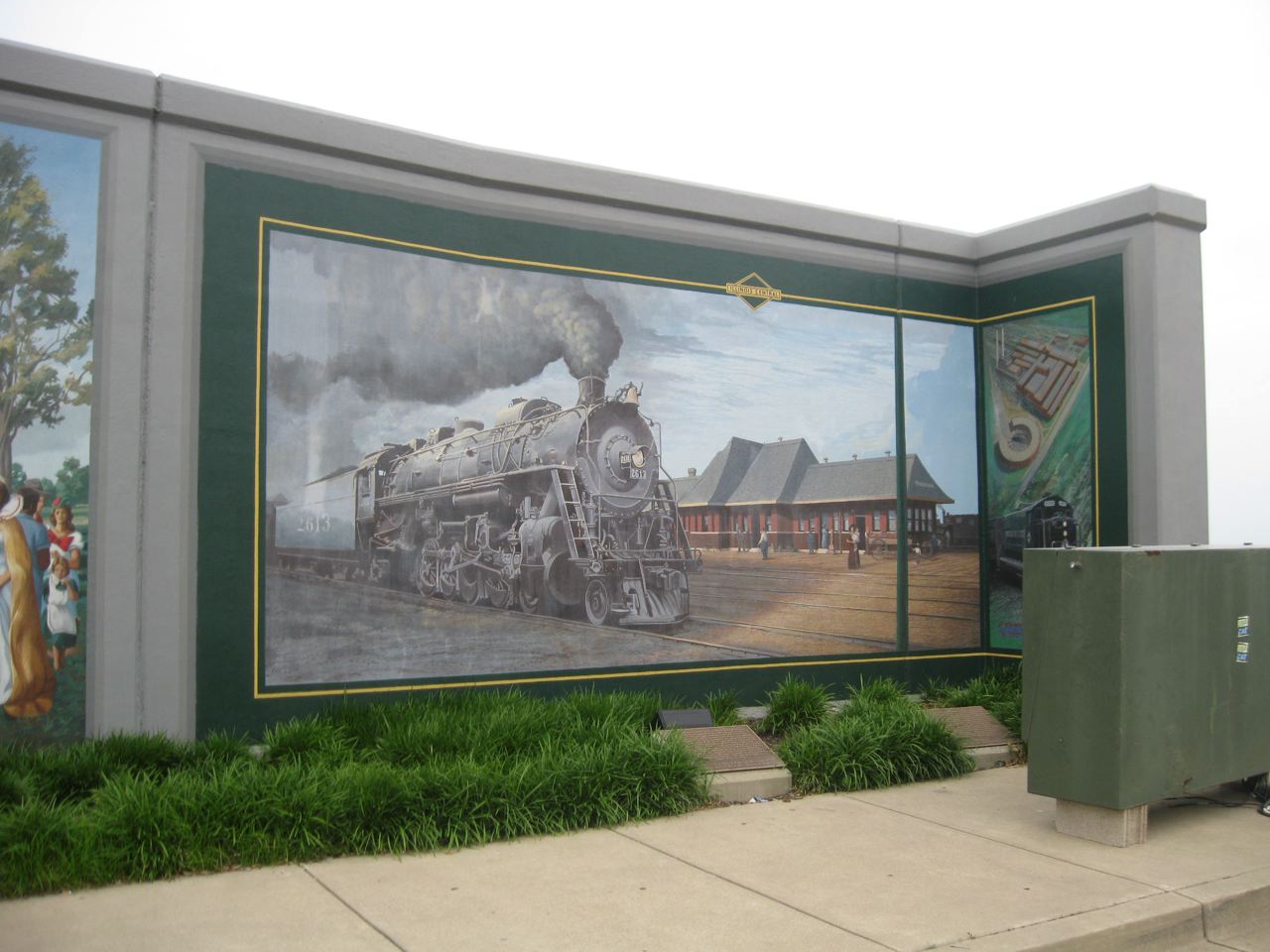 |
|
||||
|
| West of the central parking lot/park area is IC 2-8-2 1518, a baggage car, and caboose on display. The railroad museum is a block to our right. |
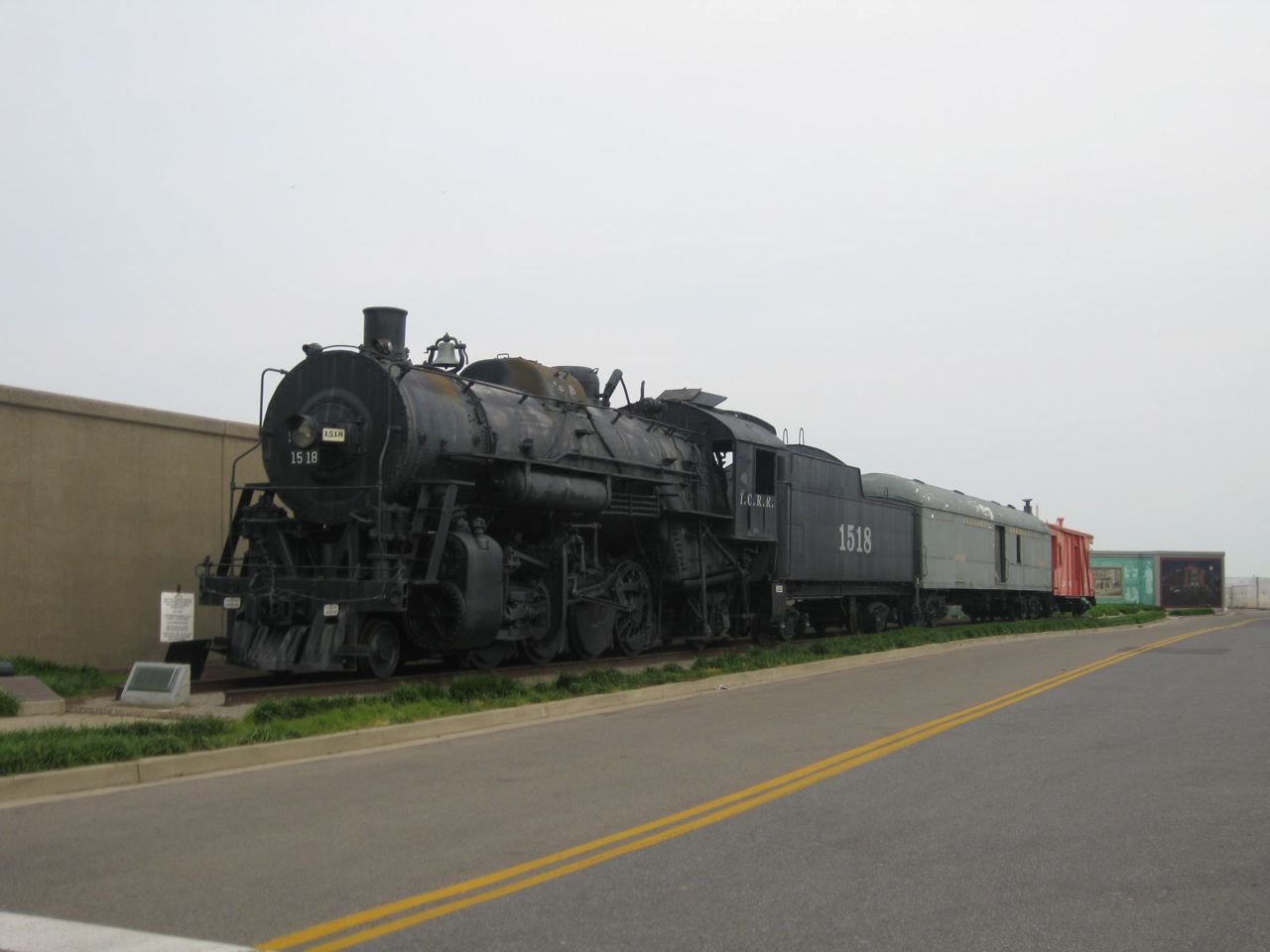 |
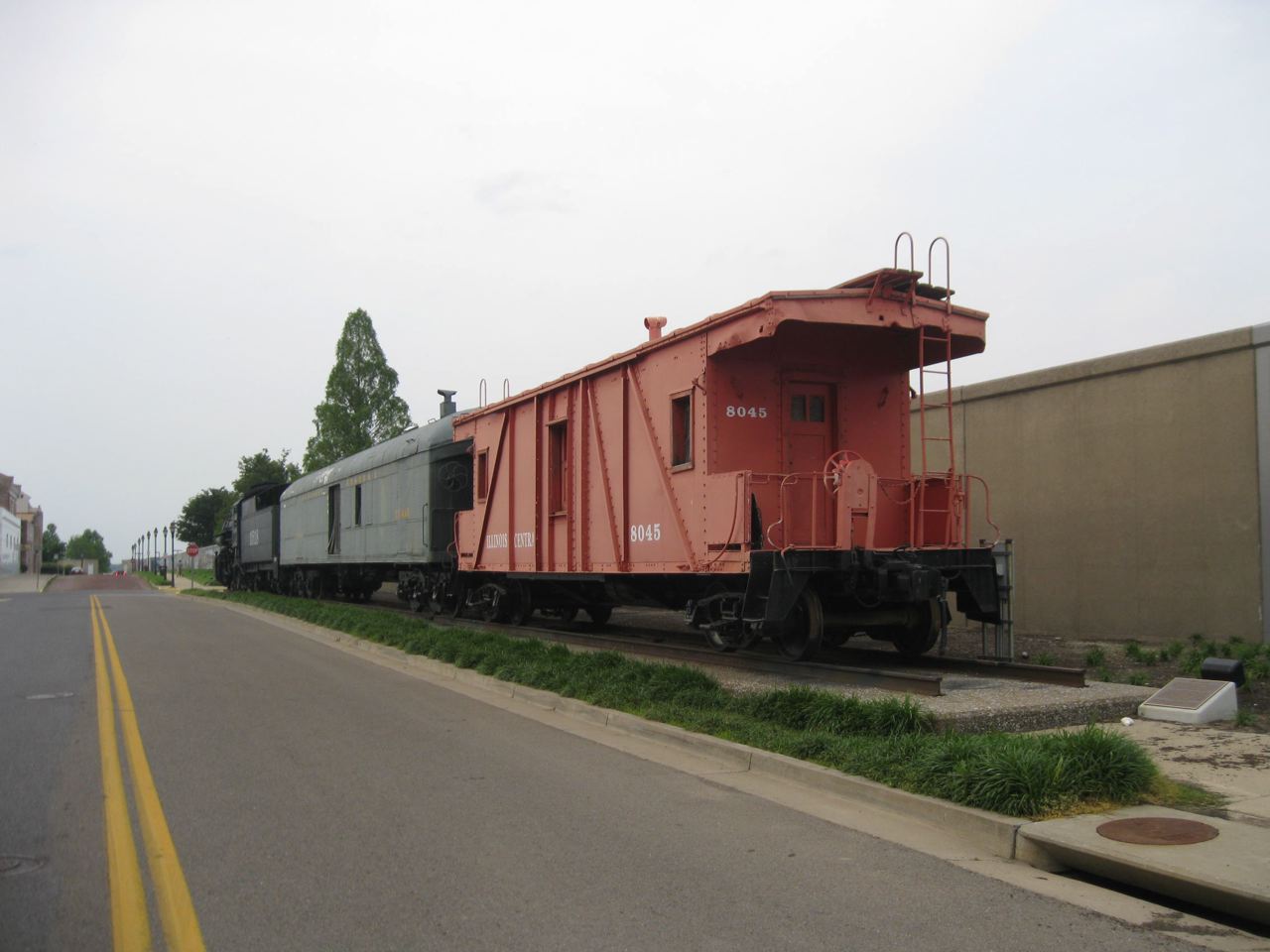 |
| The railroad museum is in the old "NC" freight house. |
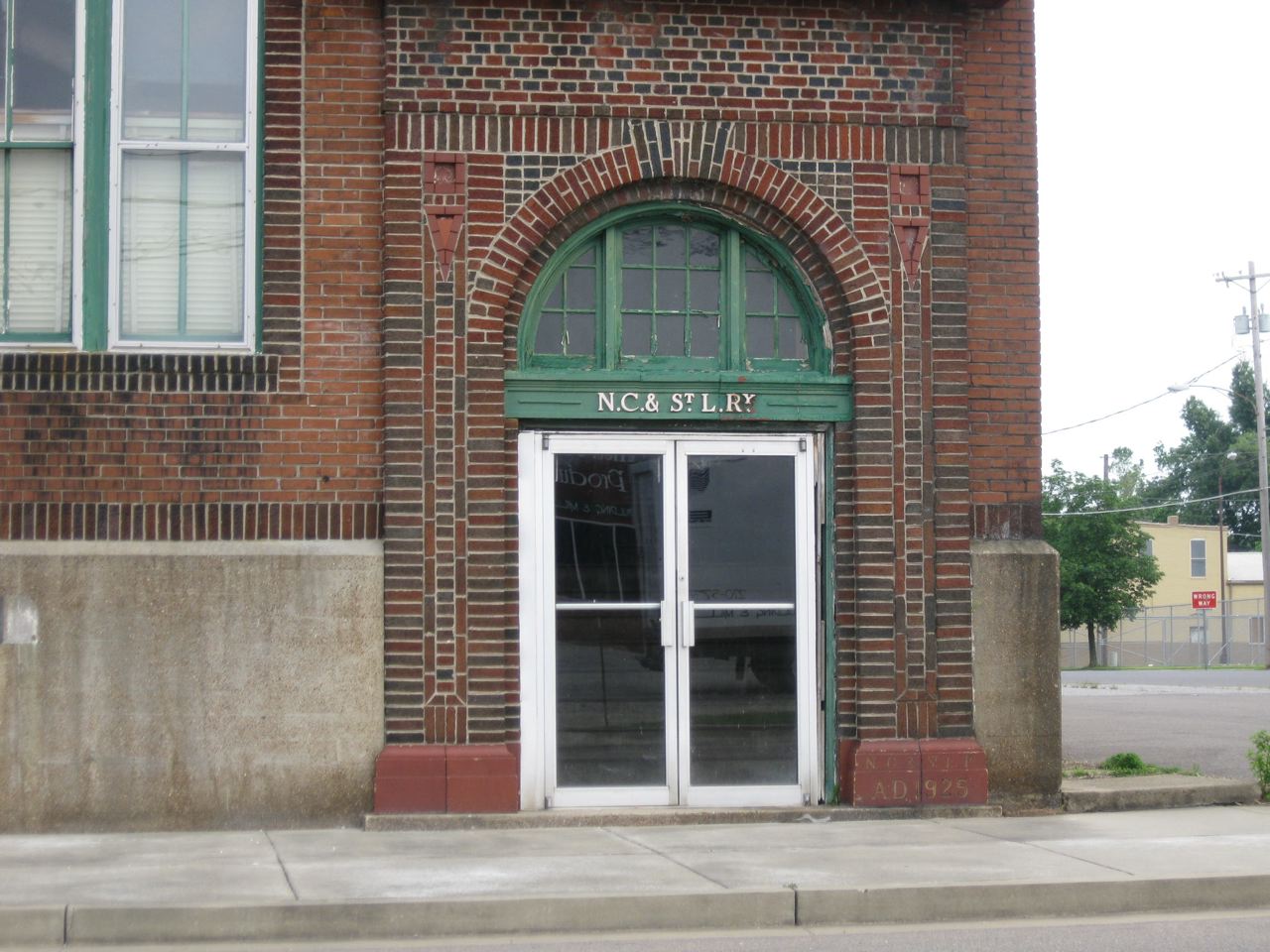 |
| Saturday, May 21, was an "off day" for 4 of us who rode the rental car. Otto Dobnick had had dinner with us at O'Charley's Friday, but hadn't ridden the Paducah & Louisville, so he was on board the Saturday side trip to Princeton, Ky., and back, sold separately. We 4 who didn't need the line (Phil Moser, Brad Phillips, Reg Mitchell, and myself), except for this 2-mile segment across the new Kentucky Dam bridge pictured, went out for one action shot of the train, then went down to Fulton, Ky., exploring, and back to Paducah and Metropolis, Ill., in the afternoon. I apologize for the fuzziness of the distant coming-on action shot; blame the little Canon Powershot camera. I was concentrating on slides! The time here is 1112 a.m.; we kept in touch by cell phone with friends on the train as to its progress. |
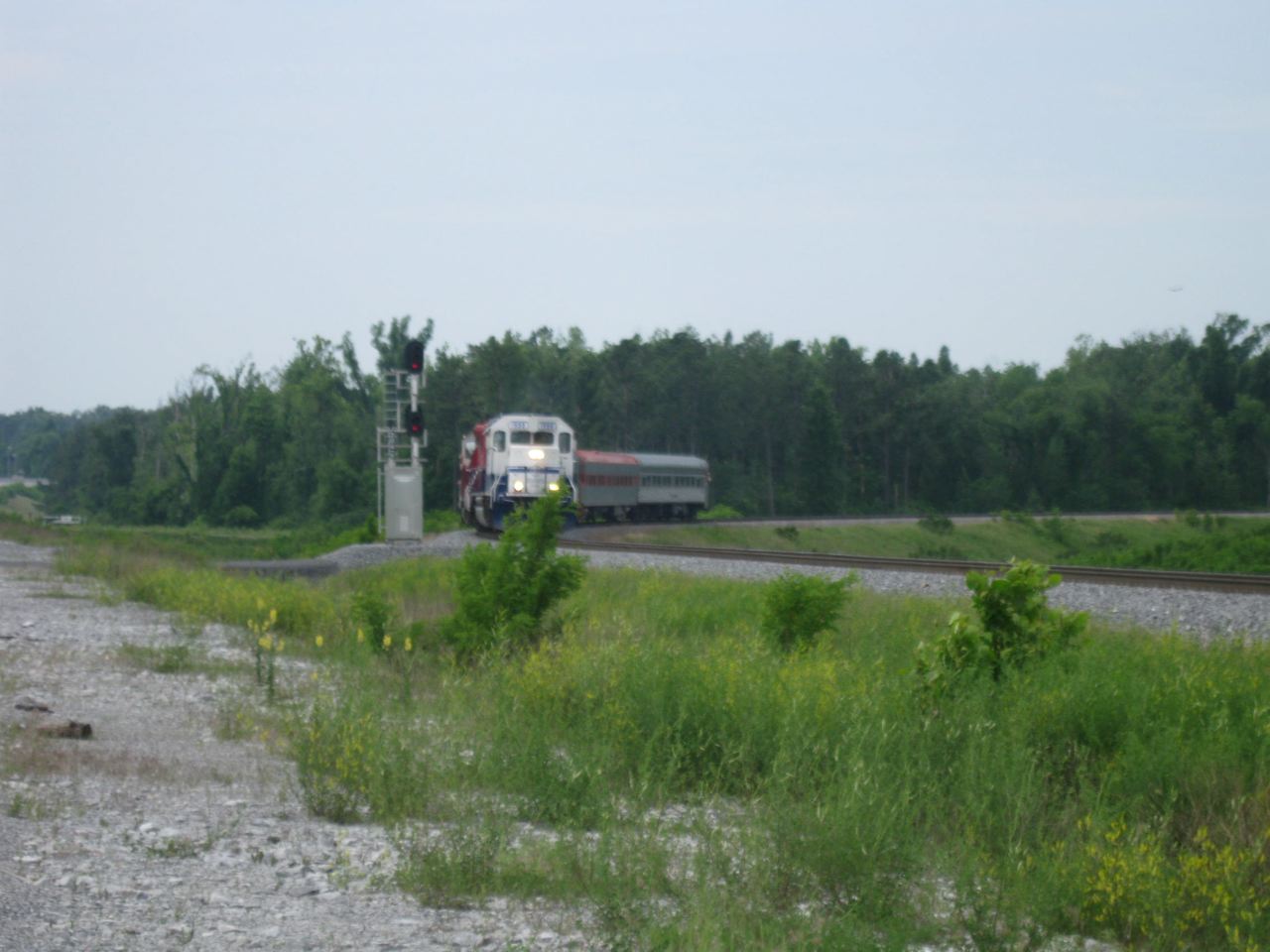 |
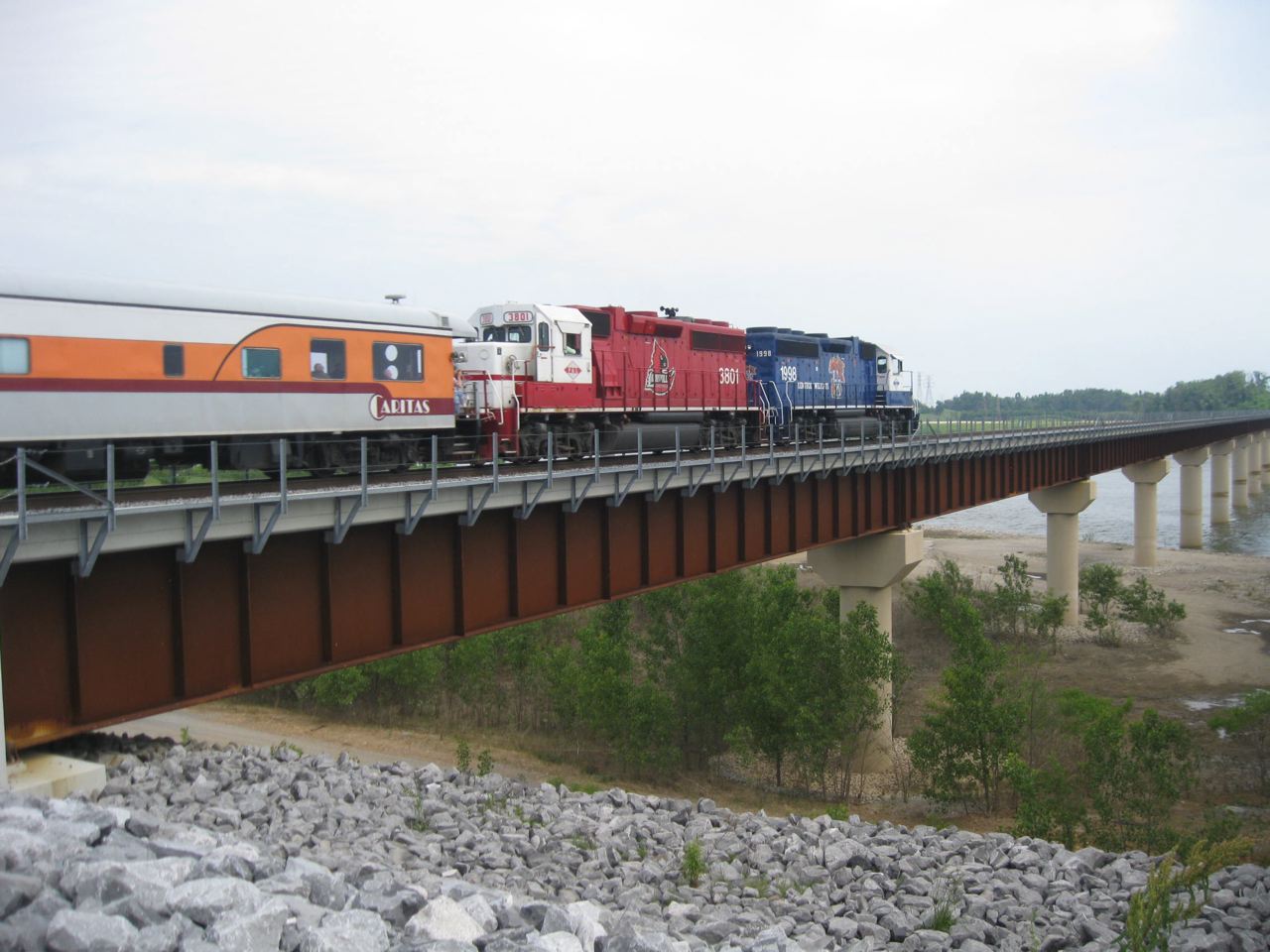 |
 |
 |
| Here is the dam itself, which the old highway and railroad both crossed. This view looks generally southeast. |
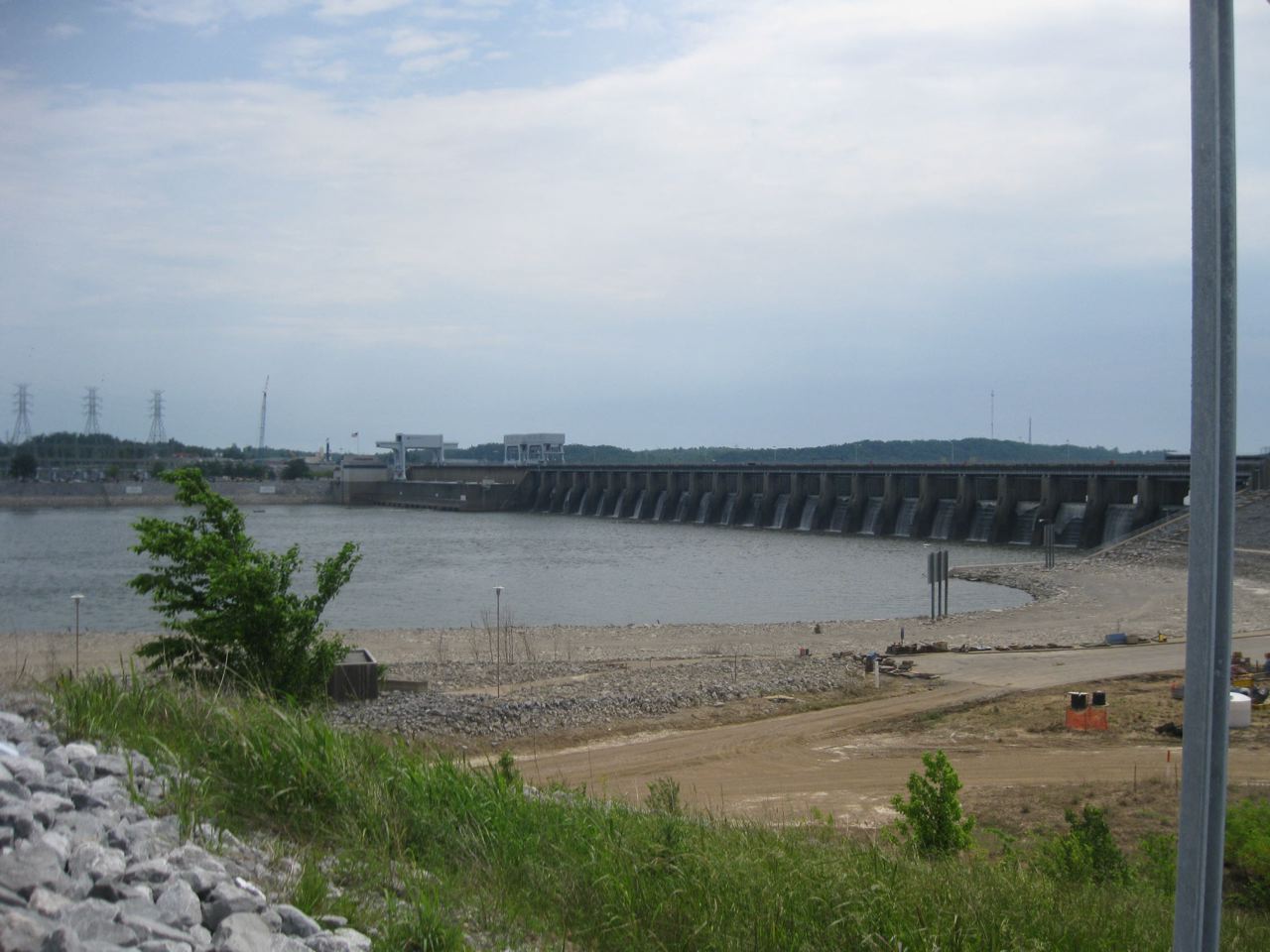 |
 |
| Surprise! As we approached Murray, Ky., we saw a Culver's billboard, so I had to stop for a soft drink to "check it off" in my "Culver's log." I have about 3/4 of their 439 outlets, but they keep expanding to keep ahead of me, and add states, too (latest are Arizona and Tennesee). |
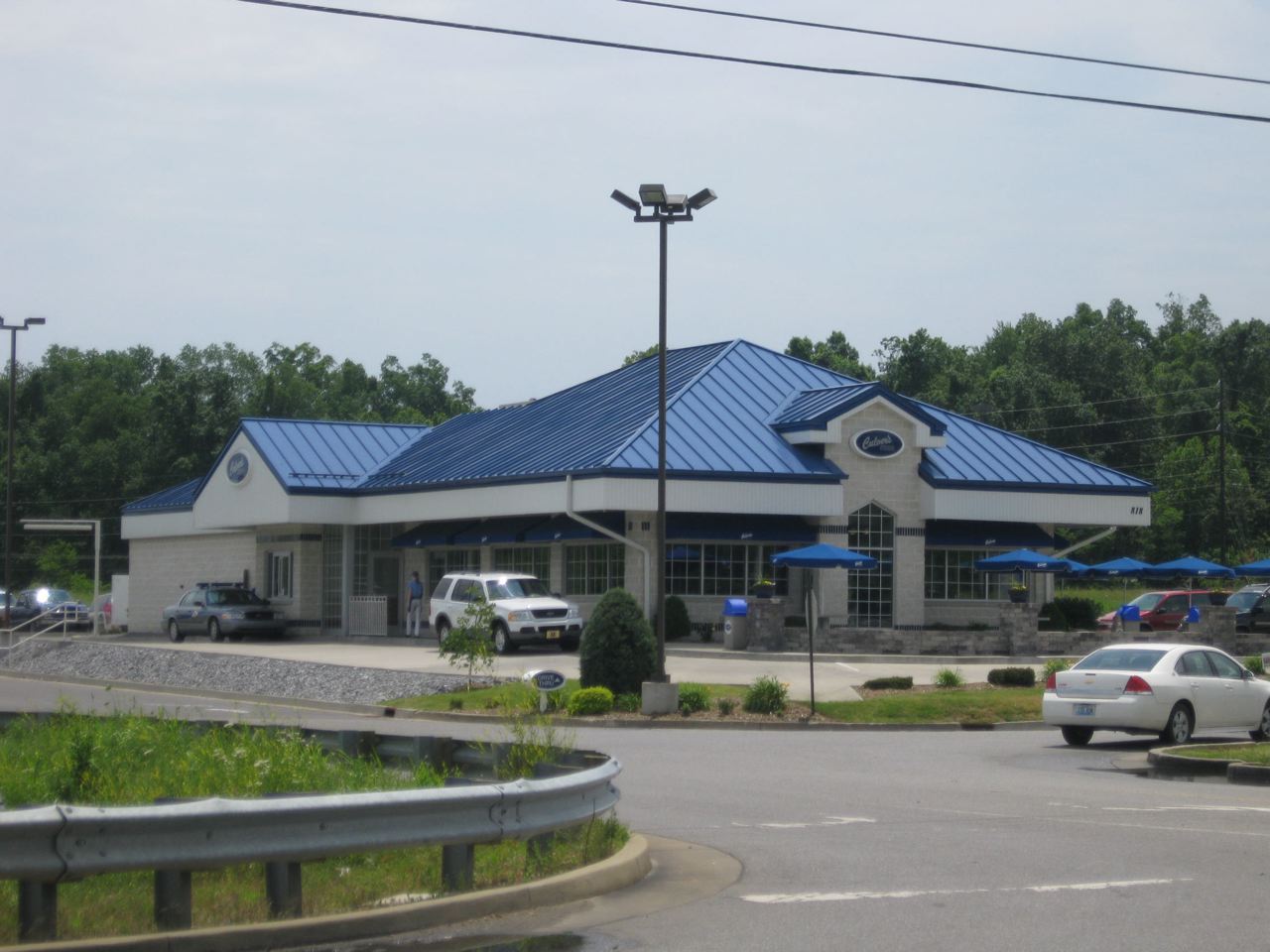 |
| The old NC&StL depot in Murray survives; the line is now a short line Kentucky & West Tennessee, from Bruceton on the old NC main line to Memphis, and ends north of here near Hardin, Ky. |
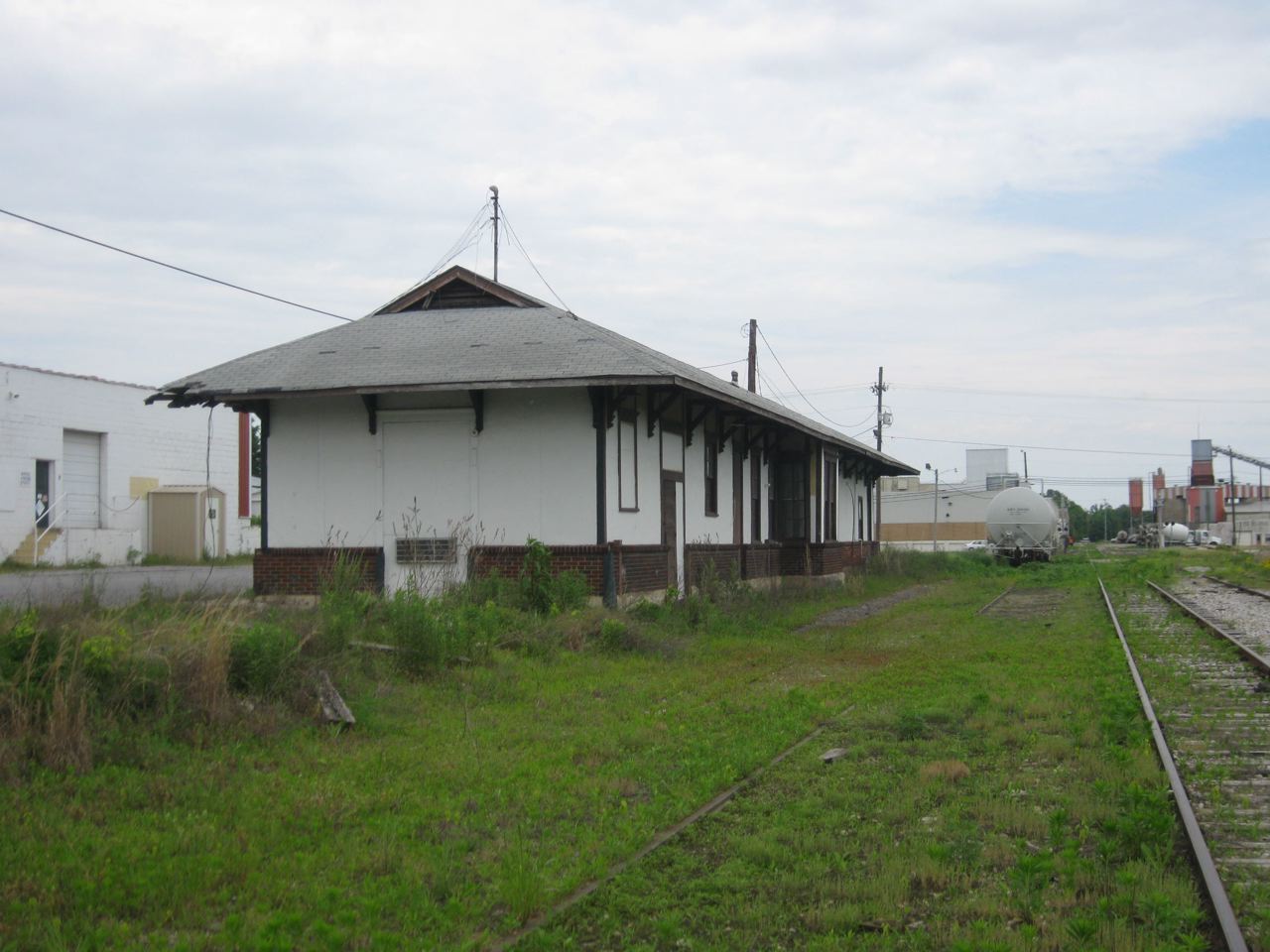 |
| At Fulton, Ky., a former IC crossroads (now a "y" jct.), this northbound was in the yard. The big old depot in the central business district, where the two lines crossed, is long gone. |
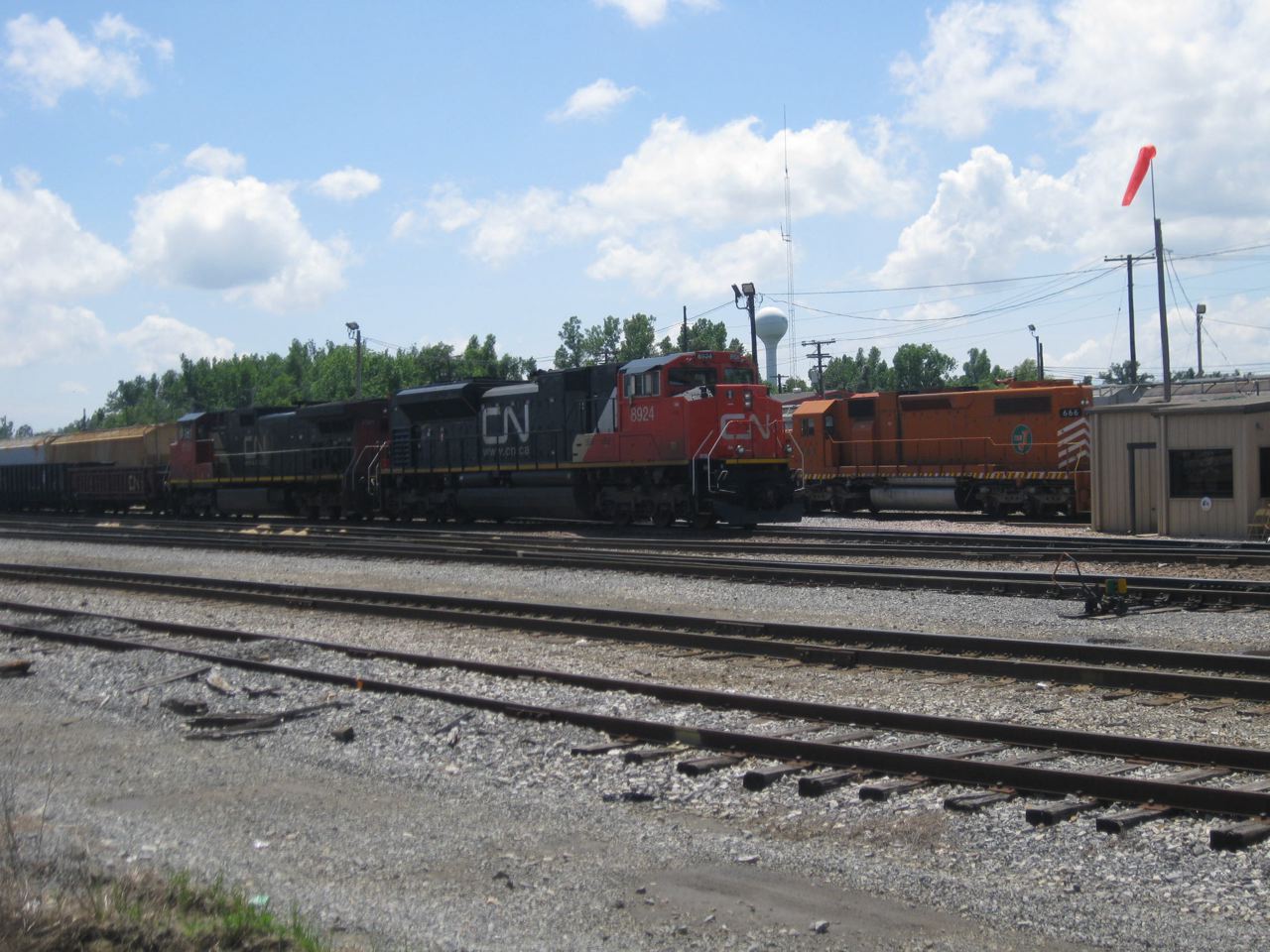 |
| CN's "Devil's Engine," EJ&E 666, was parked near the yard office. The 2501 is the northbound's rear unit; their move to make a pick-up of cars was timely for us. |
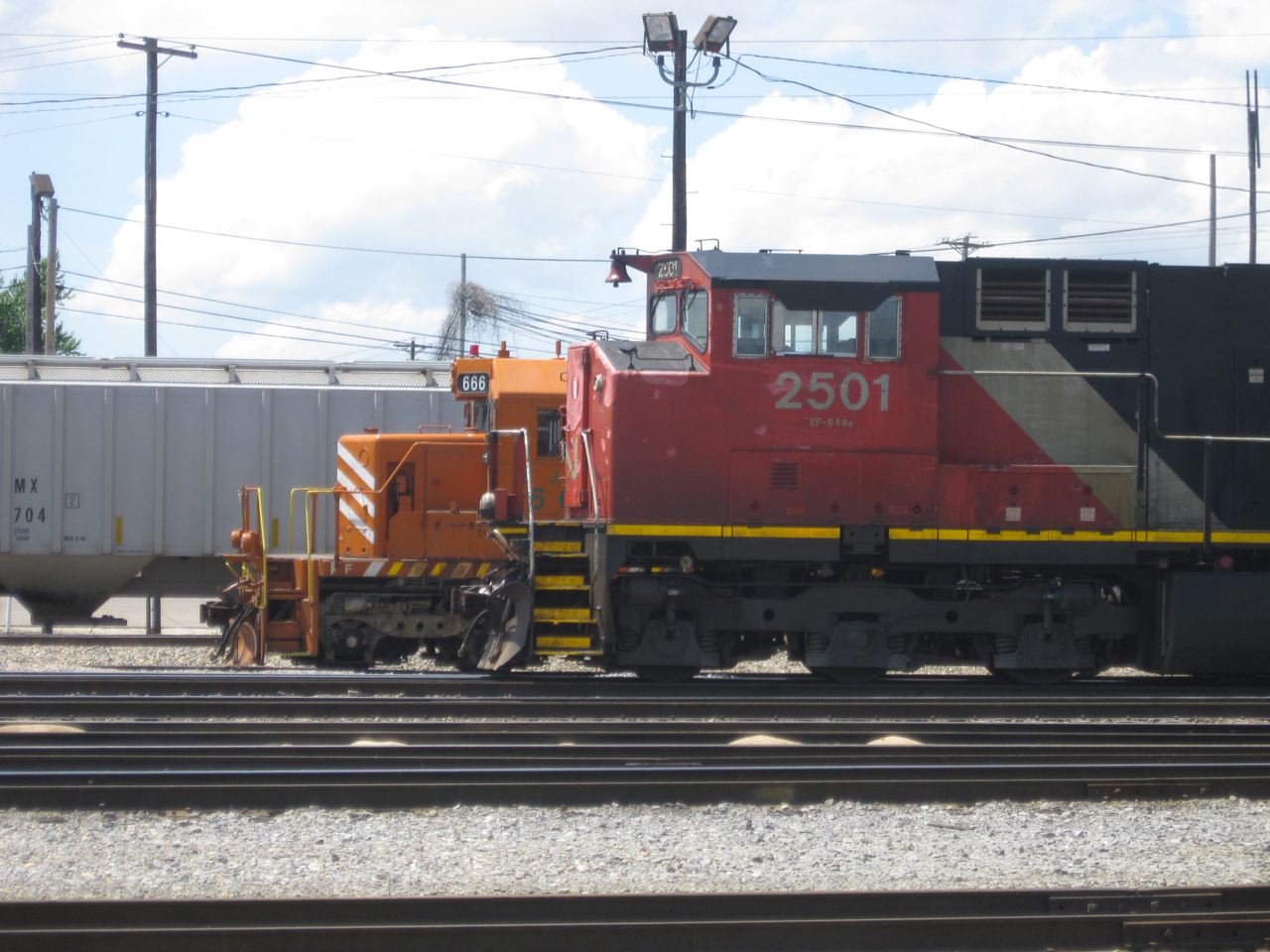 |
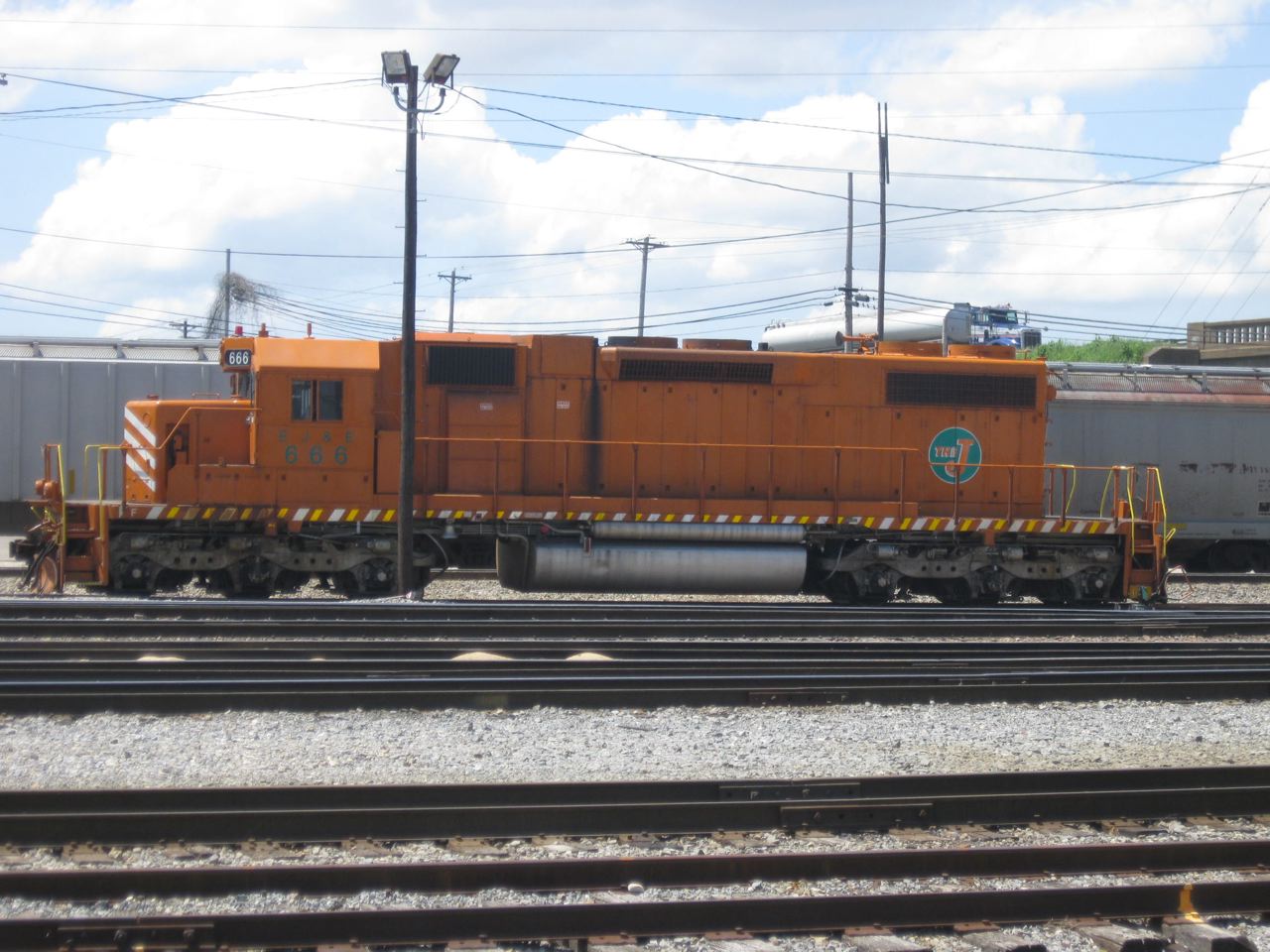 |
| What looks to be an ex-L&N caboose is on display in downtown Fulton. |
 |
| The "Am-shack" north of town on an obscure road illustrates a basic flaw on the Amtrak system, where the one daily train calls at small towns in the middle of the night. This neighboring road obviously gets a lot of traffic by mistake. | 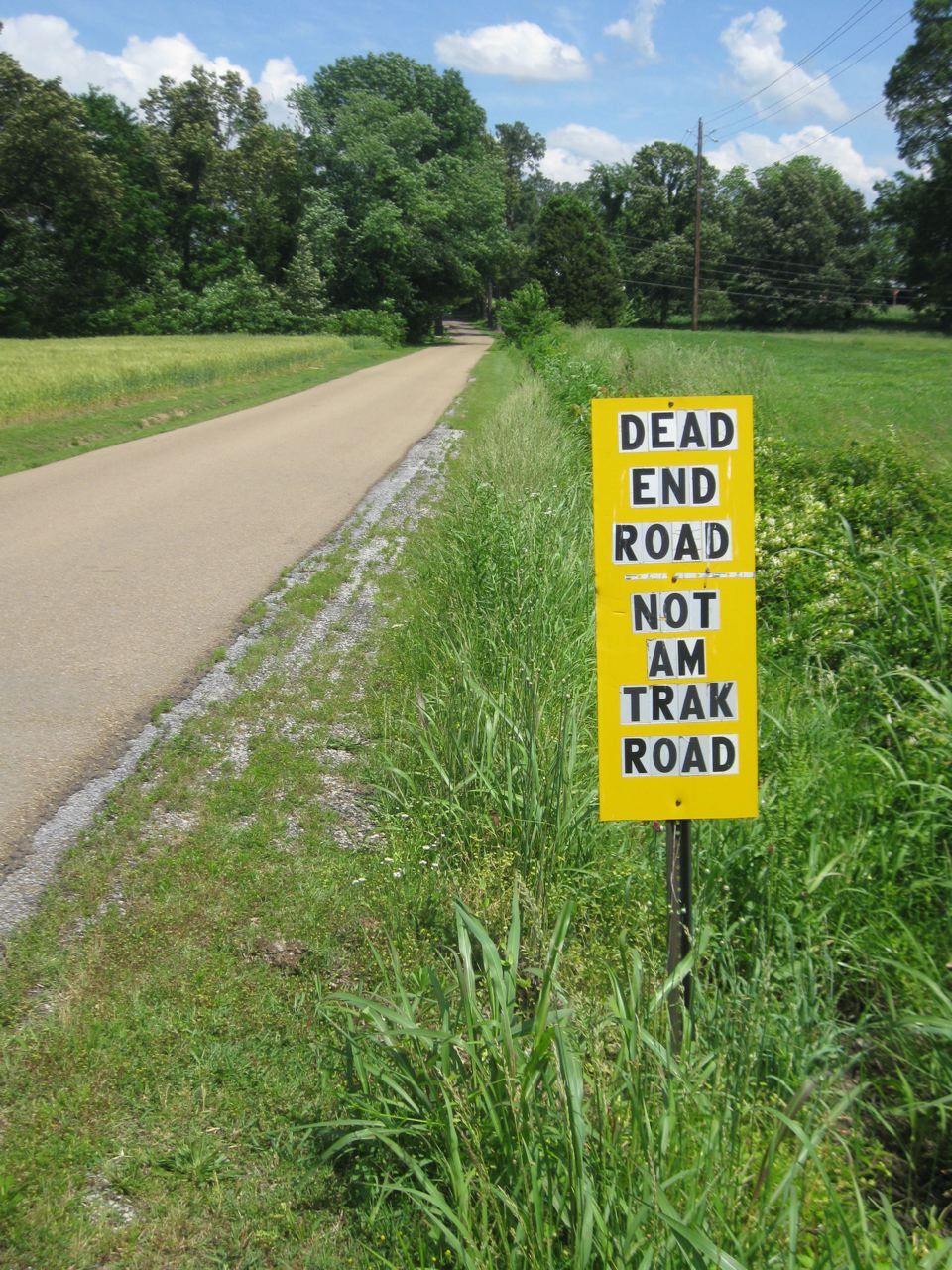 |
| The northbound freight pulled up under the Parkway bridge to near where the diamond used to be. We look southeast. The yard is to the right, now the only line through town. The track straight-ahead goes into the downtown, crosses the old city line, which came from Paducah via Mayfield, and on southeast to Jackson, Tenn., and eventually Birmingham, Ala., the route of the old City of Miami. The line to the left in this photo leads to the P&I bridge and the Edgewood Cutoff up thru southeastern Illiniois, CN's main freight route. The old line from Paducah ends now at Mayfield and is run by the PAL. |
 |
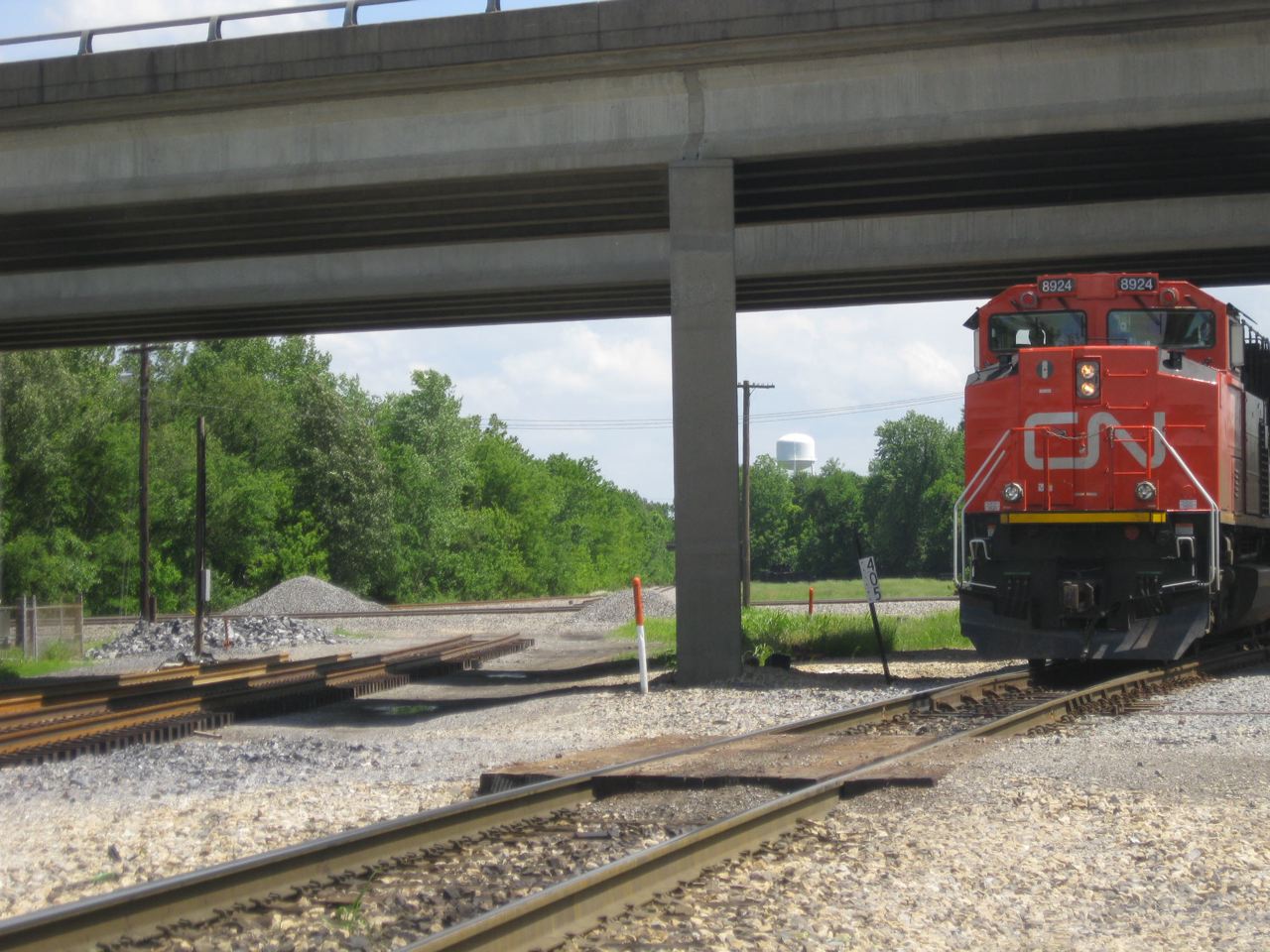 |
| This loaded coal train was waiting on the line from the P&I bridge; we weren't sure if a crew was on board or not. Track in foreground goes north, at left, to Cairo, Carbondale, and Chicago. Vantage point here is just south of the "Am-shack." |
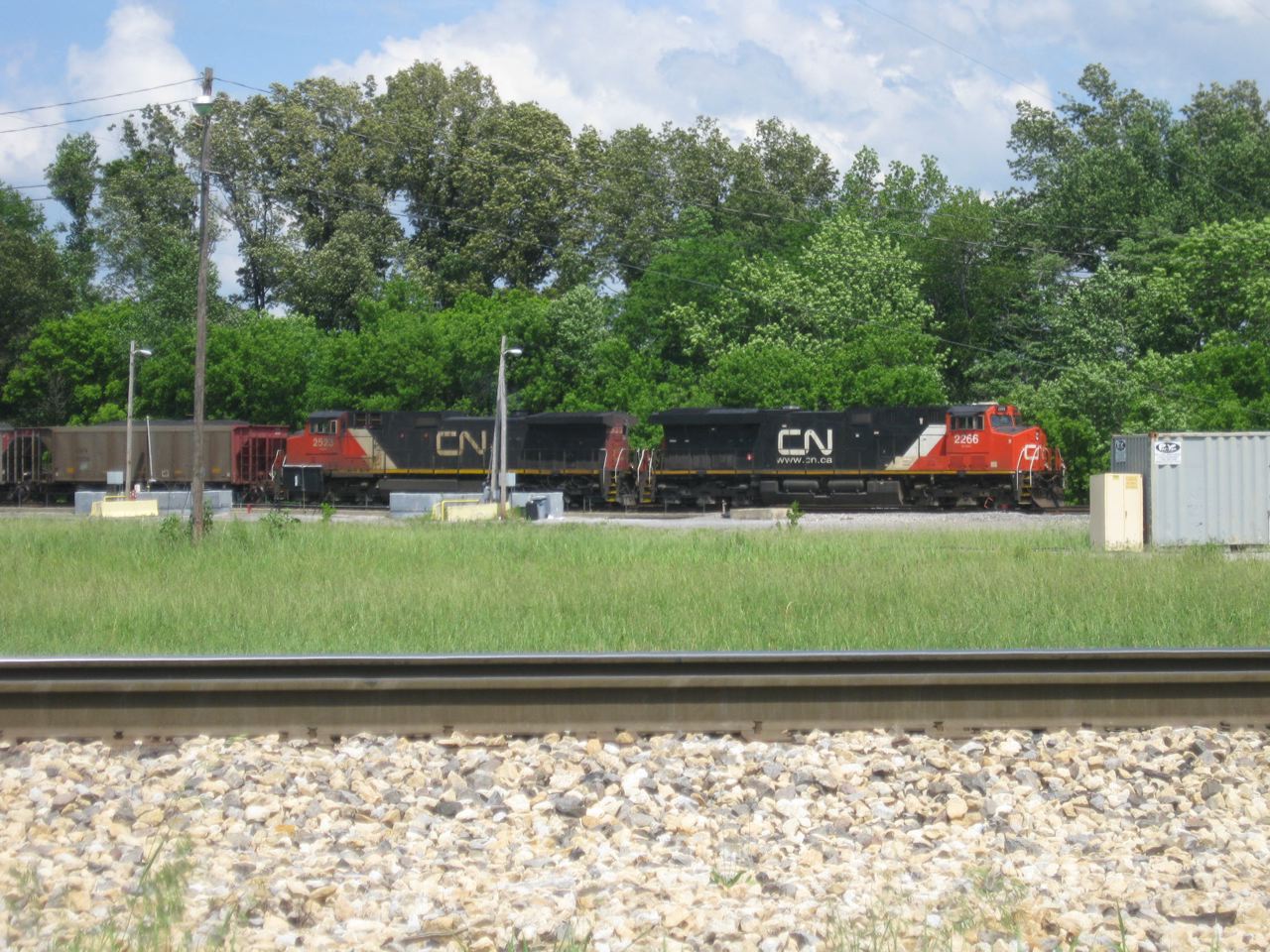 |
| Fulton's Amtrak station. What a joke. A sign on the door says the restroom is out of order and says to use Wal-Mart's! We didn't see the Wal-Mart! |
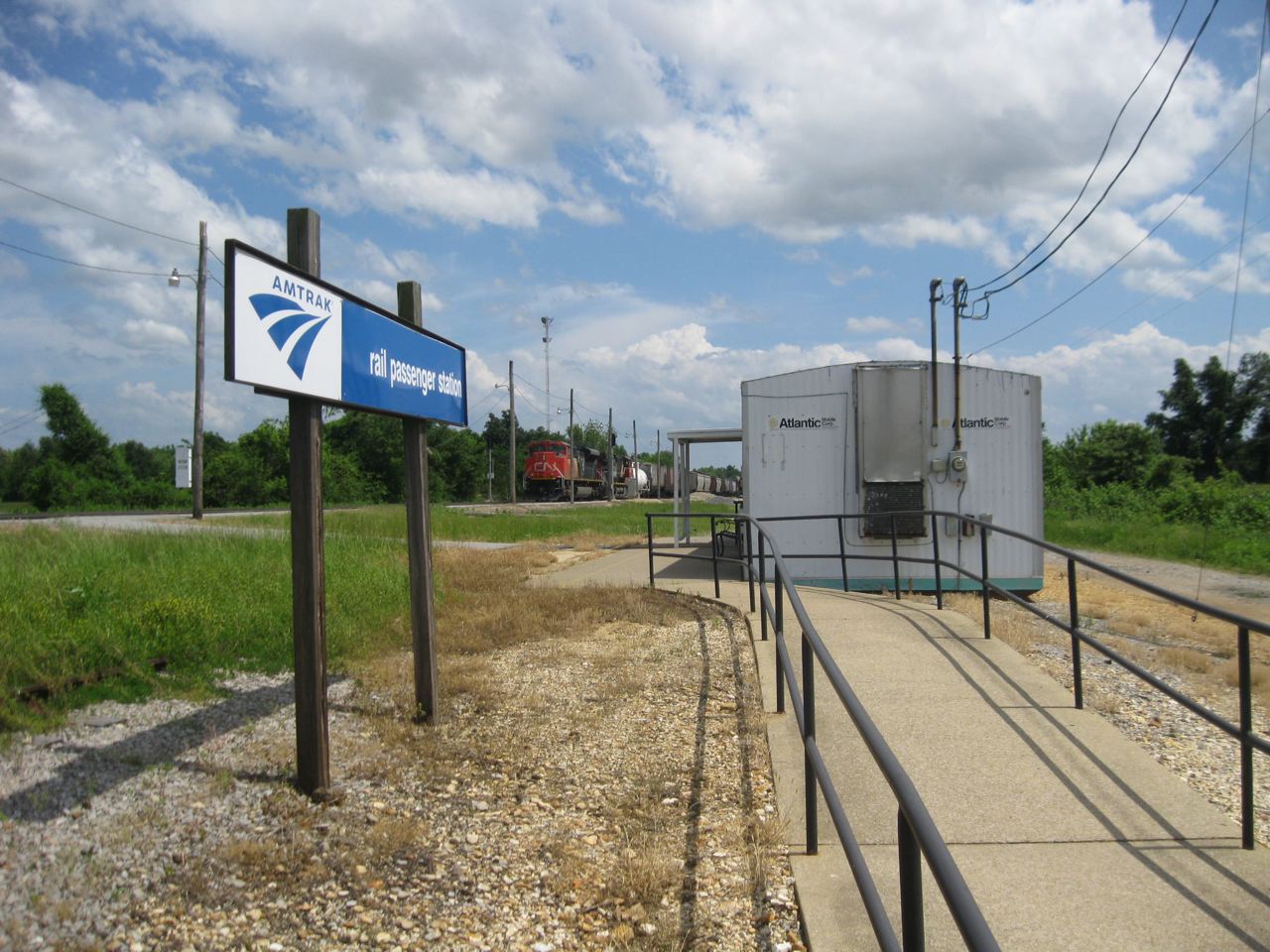 |
| The rest room doesn't work, but by gosh Amtrak put up its new standard station sign! |
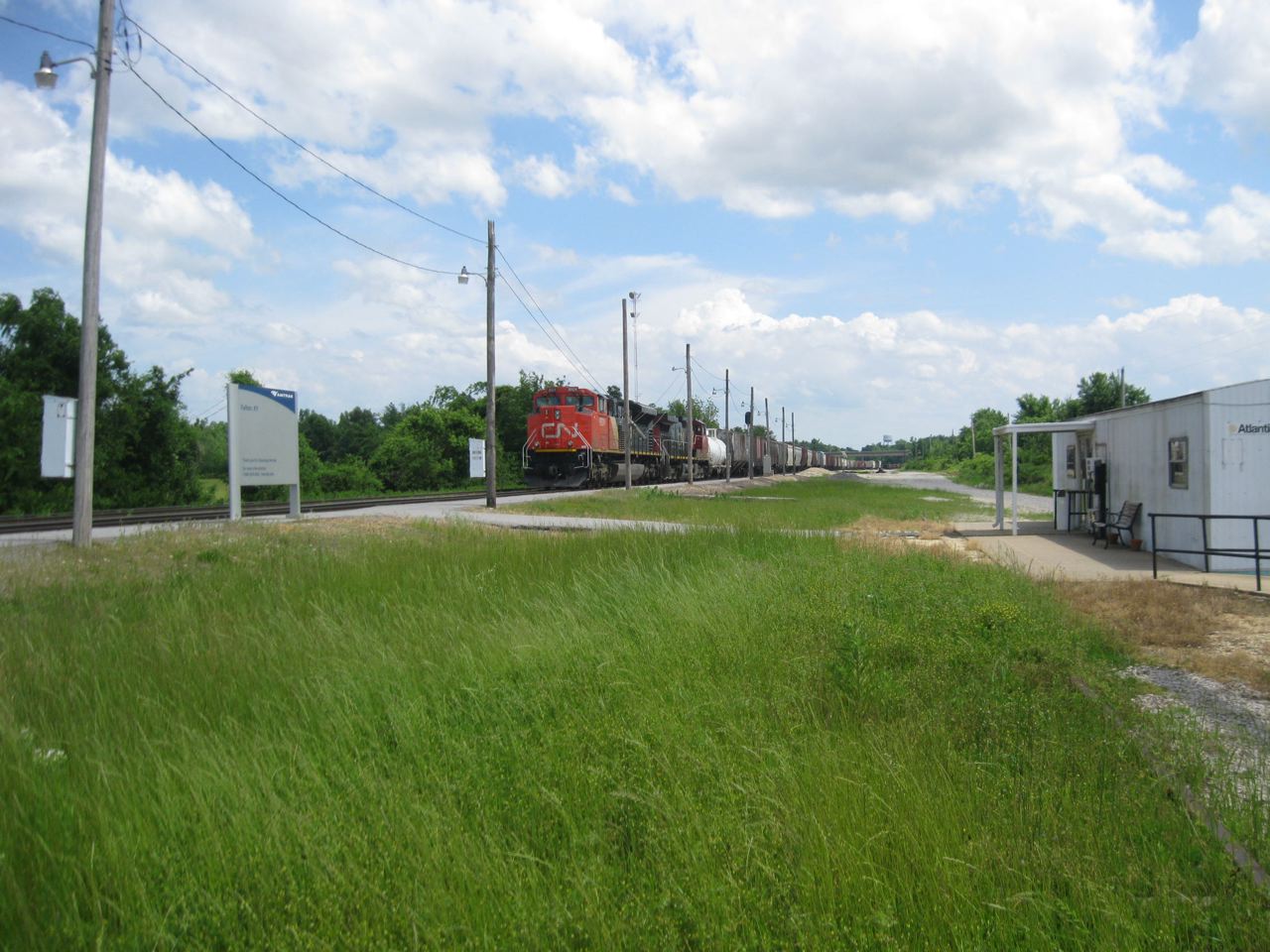 |
| Nearing Mayfield, after we checked out the south end of the trackage of the old IC route to Fulton, Brad Phillips spotted some yellow thru the trees, and we found these ex-UP units in storage, undoubtedly owned by a rival firm to VMV whose shops are in Paducah. I think these are the 6000 hp SD90MAC's at left, and behind the two Tunnel Motor SD's at right. |
 |
| We skirted Paducah on I-24 and went over to Metropolis, viewing the Superman statue (and not buying any souvenirs nearby, nor trying to use the "Daily Planet" phone booth), flood-damaged homes, and the riverfront casino, still out of business during post-flood cleanups, as were two adjacent motels. | 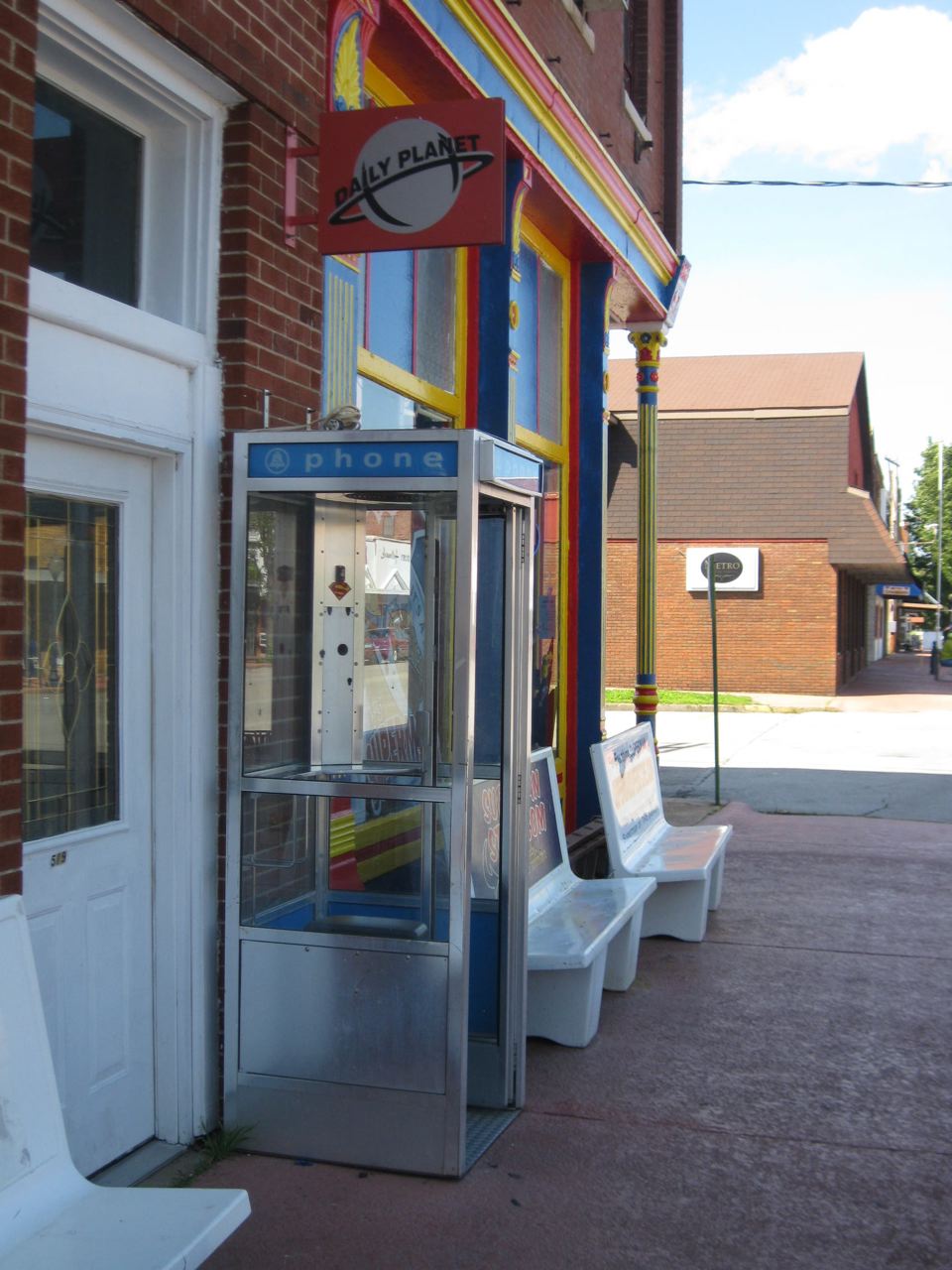 |
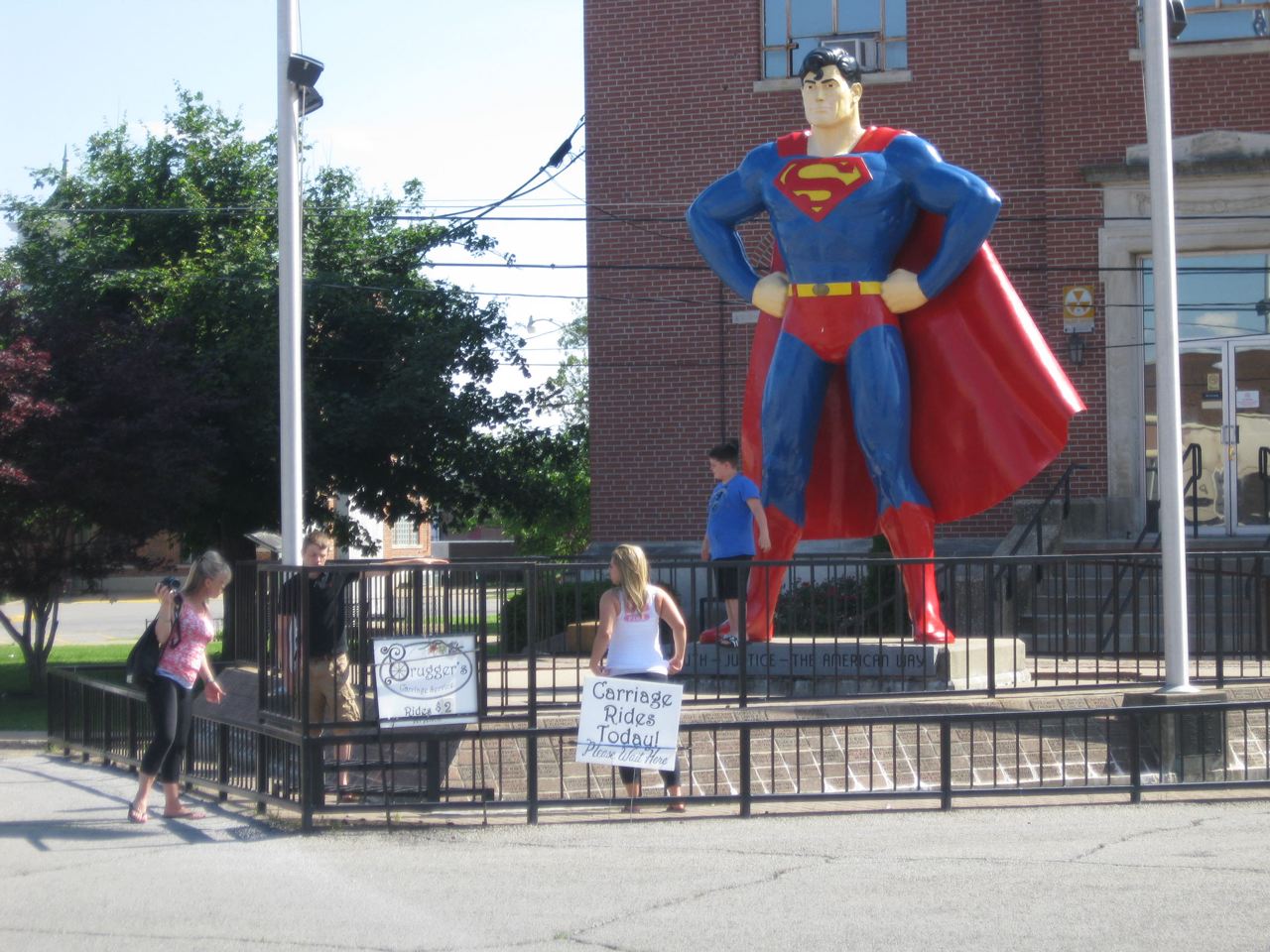 |
| The brown/white "dividing line" on the home, at the right, was the water level. Water reached a block or two inland at Metropolis, but each block is of a different gradient, so the "depth" of floodwater into town varied from block to block. I'd guess 95% of the town wasn't flooded. |
 |
| Looking east under the Illinois side approach of the P&I bridge. The high-water mark on the stop sign shows how each city block could differ greatly on being affected by the flooding. |
 |
| This guy wasn't flooded. |
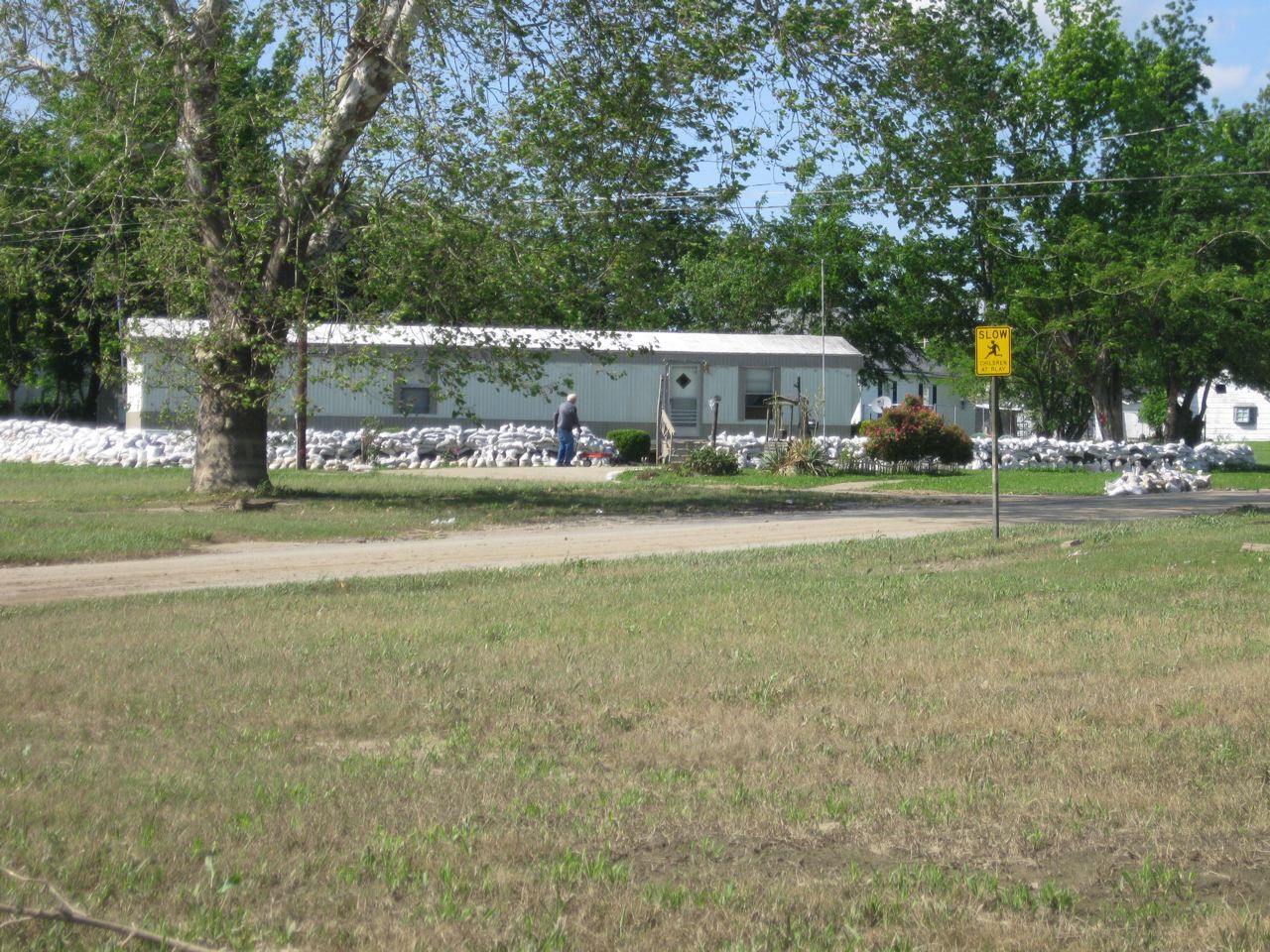 |
| Looking southwest; the foreground is all mud! |
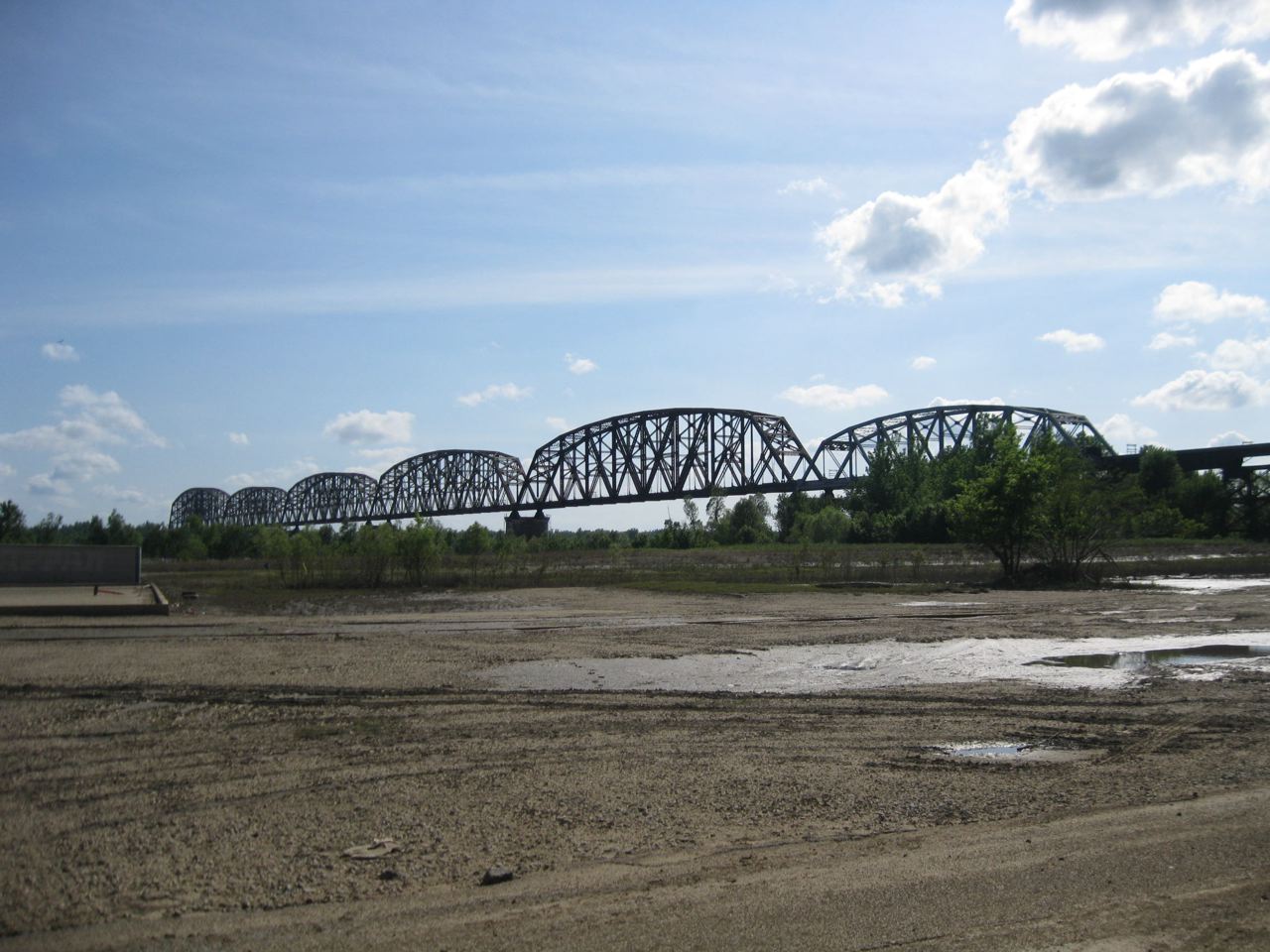 |
| We returned to Paducah thru Brookport on this narrow US 45 Ohio River bridge. |
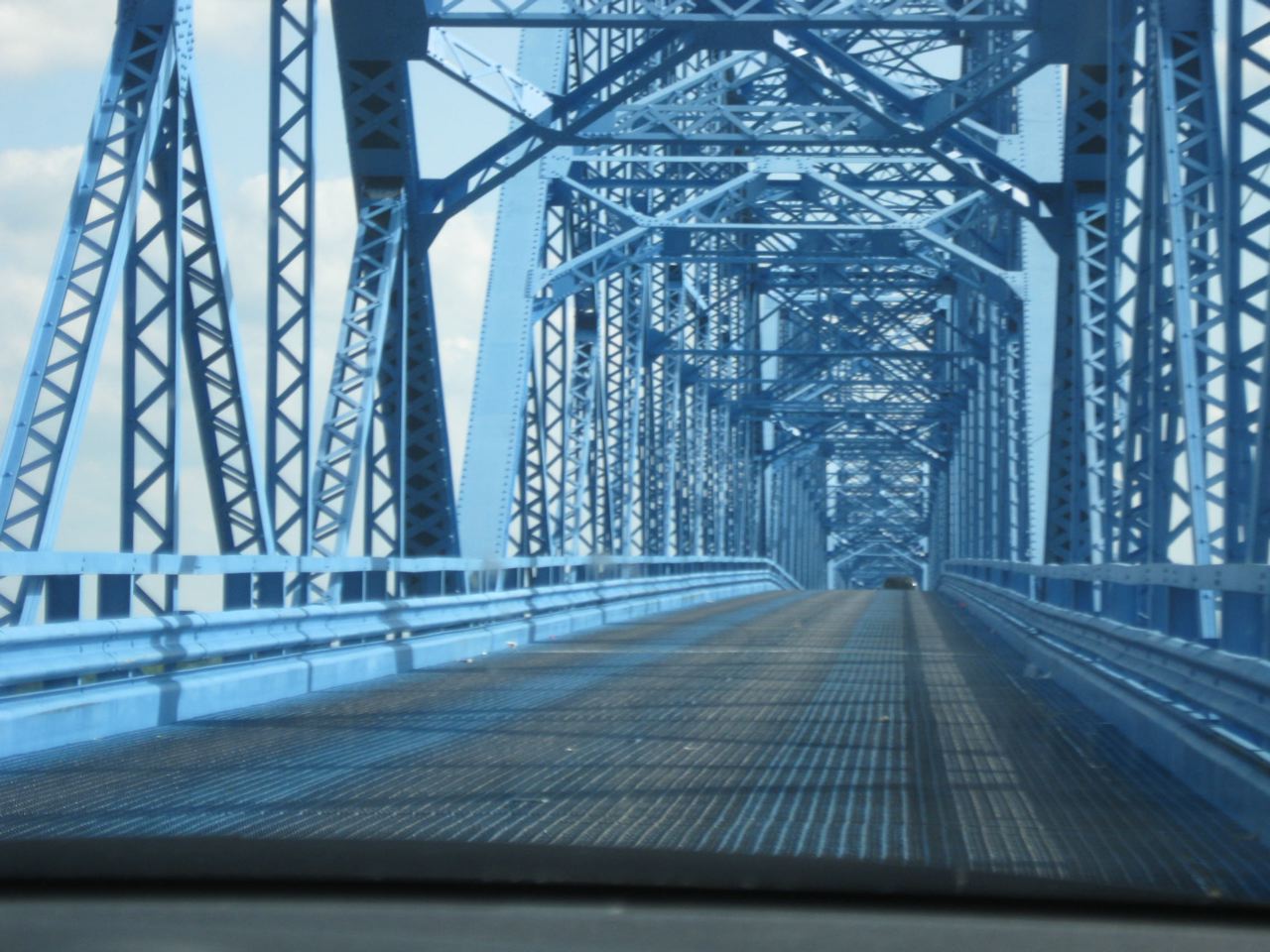 |
| Late afternoon provided a last photo opportunity of our train, with the UL unit leading. We dined at the Cracker Barrel at the I-24 interchange, and Phil dropped off the rental car and caught a taxi back to the track, about 2 miles. Tomorrow, it would be on north thru Illinois to Galesburg on the old CB&Q "coal line." |
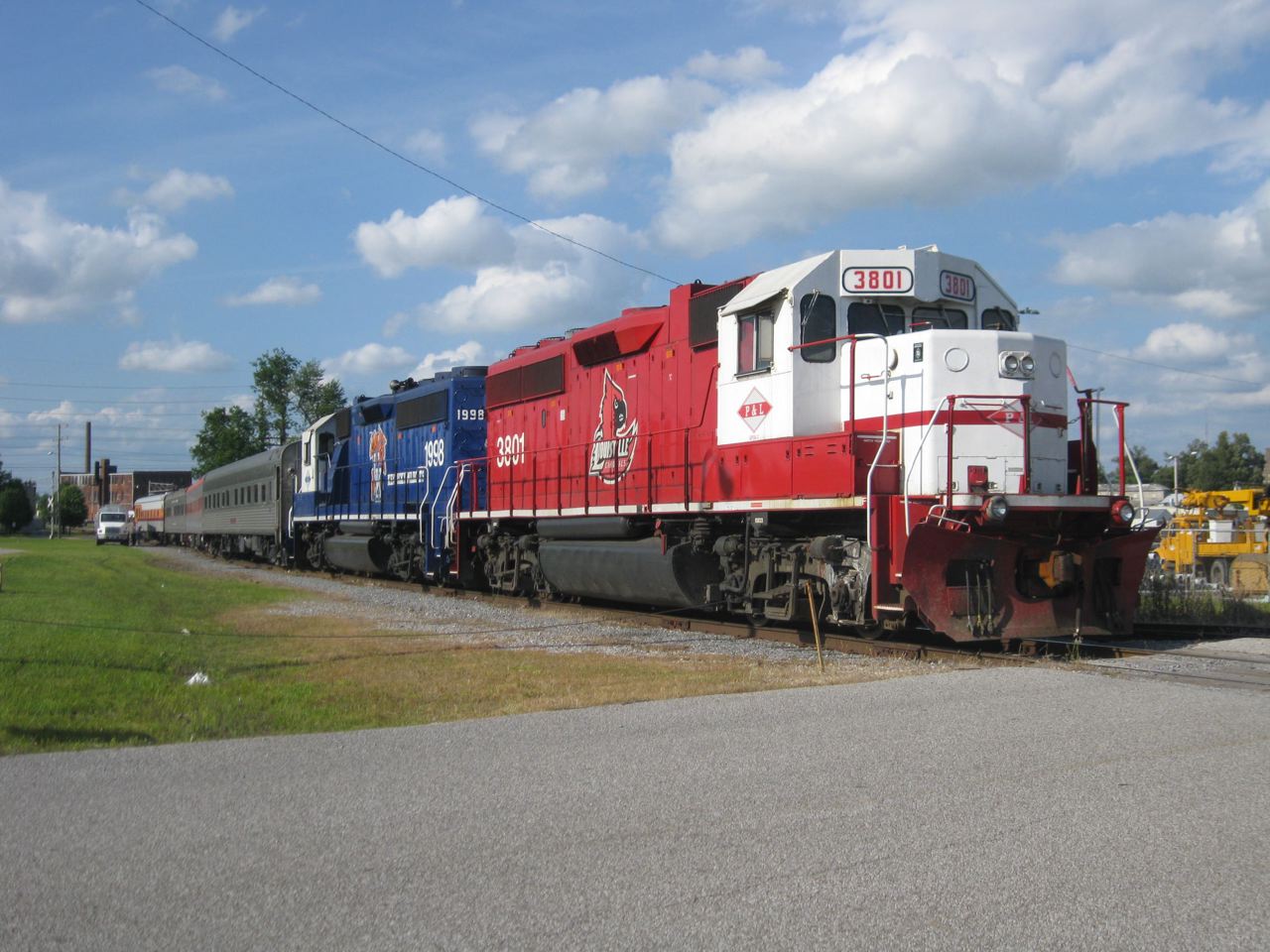 |
This page was designed and is maintained by Mike Condren. If you have materials
that you would like to contribute, contact me at mcondren@cbu.edu
